
This post contains affiliate or sponsored links. We might be paid for posting them or if you click on them or buy through them. If the affiliate link would increase your costs, we wouldn’t use it. Your trust is more important than any commission. More about our links policy here .
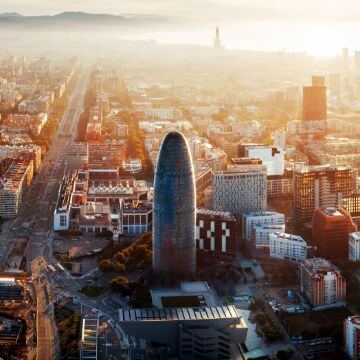

All about Torre Glories (Agbar Tower) in Barcelona
Plan like a pro the interior visit of this amazing building.
Besides Sagrada Familia, if there’s a building that really stands out in the Barcelona skyline that is the Torre Glories (also known as Torre AGBAR). A high sky scrapper with a rounded top that reminds people of a bullet, a cucumber or… things I can’t mention in a post for all public ages. It is located in the Plaça de les Glories Catalanes (hence its current name), which Ildefons Cerda planned to be the center of Barcelona when the Eixample development plan was presented, and now is a complex crossroad that the Barcelona council has been trying to pacify for ages.
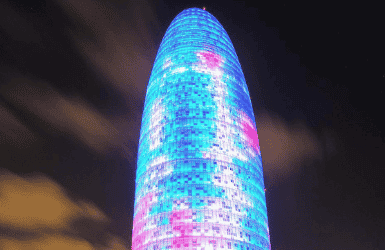
It was originally commissioned to the French architect Jean Nouvel by the Aigues de Barcelona holding to be their iconic headquarters. The acronym of the holding is AGBAR, so the tower was originally called "AGBAR Tower". The construction took between 1999-2004. The water company of Barcelona occupied the building for just over a decade, until it was sold in 2017 to the real state company Merlin States, that continued to rent the space for office use. In 2022 the top of the tower was opened for visits as a vantage point.
The Torre Agbar building
Despite the many nicknames that people has given to Torre Glories due to its “inspiring” shape, its creator Jean Nouvel states it’s supposed to look like a geyser, as a tribute to its original owners, the water company. He’s also acknowledge the influence of the shapes of the Sagrada Familia towers as well as the mountain of Montserrat . Its circular floor plan was choosen to avoid having a main façade, facing instead all the neighborhoods around it.
The exterior of the building is a double façade: an outside a shell of glass blinds, and only separate from it by a maintenance passarelle, the colored aluminium wall with more than 4.500 openings. The glass blinds incorporate sensors that detect temperature, light levels, wind and other weather variables. A special software regulates their degree of inclination to maximize the comfort inside the building, as well as to make a more efficient use of energy.
Torre Glories inside visit tips
How to get there & visit tips.
ADDRESS : Avinguda Diagonal, 211 . WEBSITE : https://www.miradortorreglories.com/ CLOSEST SUBWAY STATION : Glories, on L1 (red line) CLOSEST TRAM STATION : Ca l’Aranyó (T4, T5, T6) BUS TURISTIC (hop-on, hop-off bus) : Glories stop on red line.
- It is obvious, but avoid if you suffer fear of heights.
- Check the restrictions for the Clouds Cities Barcelona installation : it is not for kids under 12yo, pregnant ladies and people of a variety of physical conditions. The rest of the visit is entirely accessible.
- No need to arrive earlier than 10 minutes before your entrance time: they won’t let you in anyway.
- Keep your ticket until you leave the building: you’ll be asked to re-scan it on your way out.
- Avoid visiting during the last of their opening hours: they typically start telling people to leave around 30 minutes before closing. You don’t want to feel rushed or constantly annoyed by the staff and the PA messages.
While the building is still mostly used for office purposes, in 2022 a vantage point has been opened to the public. The access for visitors isn’t through the main door, though, but via a glass cube located in one side of the tower. Your visit will take you first to the basement, where you’ll walk through the space called “ Hyperview Barcelona “: a combination of 4 art installations that use video, photography, big data and museum-like displays to introduce you to the many sides of Barcelona.
Next you’ll proceed to take the elevator to the 30th floor – the Observation Deck . It’s the highest 360º view you’ll get over Barcelona, at 125m/410ft of height. Sure, La Pedrera, the deck of the Las Arenas mall and the rooftop of the Barcelo Raval hotel also offer 360º views, but they are definitely not as tall – click here for more places to see the city views.
The dome of the observation deck is decorated with a walk-in sculpture by Tomas Saraceno: “ Cloud Cities Barcelona “. If you’ve paid the combo ticket, you’ll be able to enter it and follow a fascinating one-way itinerary through a honeycomb of ropes and plexiglas platforms that evoke how our actions affect the entire community.
What else to see in the area
Where to eat nearby, agbar tower light show, light shows.
The AGBAR Tower lits up every night, 7PM to 11PM in the winter and 9PM to 11PM in the Summer. It displays a combination of red, orange and blue colors that evoke a geyser, but the colors don’t move: they stay still. The tower can be seen from many points in the city, but if you decide to see it from closer, make sure to approach it from the side of the Disseny Hub Museum.
In the plaza between this museum and the Encants flea market you’ll find the installation “ BruumRuum “: LEDs inserted in the pavement that illuminate depending to the ambiance noise detected by sound sensors. It’s the perfect complement to the AGBAR tower lights!
Besides this, the Torre Glories offers special light shows on particular dates, local festivities, the Llum BCN festival in Februrary, or even New Year’s Eve.
More Torre Agbar facts
- The Torre AGBAR is often compared to Norman Foster’s 30, St. Mary Axe in London, also known as “The Gherkin”. Both buildings were built quite simultaneously: the London one between 2001-2003, and the Barcelona one between 199-2004. The London building is higher, featuring 180 metres (591 ft) of height, whereas the Barcelona one is 144.44 m (473.88 ft) because the city council woulnt’ allow it to go higher, despite Jean Nouvel original plans.
- Twice (2006 and 2007) the building has been climbed by a peace activist called Alain Robert to gather attention about the situation of Lebanon.
- The Aigües de Barcelona company trademarked the name “Torre AGBAR” as an alcoholic drink brand, but it’s not been used as such (it might just be they wanted to prevent other companies from using it).
Will you visit the Glories Tower in Barcelona?

RESEARCHING FOR A TRIP IS TIME-CONSUMING… Need more inspiration?
Our 100% FREE Barcelona Collection will give you everything you need to organize the trip of your lifetime to Barcelona.
BEST INSIDER TIPS FROM THE PROS!

- Privacy Overview
- 3rd Party Cookies
- Cookie Policy

This website uses cookies so that we can provide you with the best user experience possible. Cookie information is stored in your browser and performs functions such as recognising you when you return to our website and helping our team to understand which sections of the website you find most interesting and useful.
This website uses Google Analytics to collect anonymous information such as the number of visitors to the site, and the most popular pages.
Keeping this cookie enabled helps us to improve our website.
Please enable Strictly Necessary Cookies first so that we can save your preferences!
More information about our Cookie Policy

Barceló Experiences
Suggestions for you

Dominican Republic

Riviera Maya

Fuerteventura

Gran Canaria

San Sebastián

Torre Agbar, the launchpad for Barcelona’s technological advancement and sustainability
On Avinguda Diagonal 211, and close to the Plaça de les Glòries, stands a skyscraper, 145 metres and 34 storeys high, that has become a symbol for the new Barcelona . Opened in 2005, Torre Agbar (or to give it its official name, Torre Glòries ) designed by the French architect Jean Nouvel, ruffled a few feathers in the beginning thanks to its unique appearance: it is shaped like a bullet or a cucumber—but with the passage of time, it has established itself as part of the Barcelona skyline. Perhaps because, with its curved lines and oval shape , it aspires to enter into a silent dialogue with Gaudí’s Sagrada Familia and the mountain of Montserrat —while at the same time representing the idea of a new, modern, technologically pioneering and sustainable Barcelona. Its location places Torre Agbar [Agbar Tower] at the gateway to the 22@ technological district , which has transformed 200 hectares of the former industrial area of Poblenou into Barcelona’s version of Silicon Valley.
A ‘green’ building that is illuminated at night
Torre Agbar is considered as an example of bioclimatic architecture , and in 2011 it was awarded Green Building status by the European Commission, thanks to its energy efficiency and its low level of CO 2 emissions. One of the keys to its low level of energy consumption is the use of lightweight materials that take advantage of Barcelona’s Mediterranean climate. The tower is clad in 60,000 aluminium and glass slats which incorporate photovoltaic plates ; these store enough solar energy to make the whole building self-sufficient. In addition, both the heating and the interior lighting are regulated by a smart computerised system that prevents unoccupied areas of the building receiving heat and light.
During the daytime, the play of different colours, the refractions and degrees of transparency of the aluminium slats as they reflect the sun’s rays create beautiful chromatic scales that change according to the time of day, or even the season of the year. At night, 4,500 LED devices illuminate the tower with beautiful colour shifts of up to 16 million shades, graduating from warm shades at the base to cold tones higher up.
Spectacular from the outside, jinxed on the inside
In spite of its dazzling appearance, Torre Agbar has been less successful in terms of its functionality. It opened in 2005 as the corporate head office of Grupo Agbar, and offered office space for rent, but high costs and the impractical facilities eventually drove out all the companies, including Agbar itself. The situation was not helped, either, by cases of lipoatrophia semicircularis (otherwise known as Sick Building Syndrome) being diagnosed among workers. Over the following years, projects emerged in an effort to find a new use for the building (including a luxury hotel , and a potential head office for the European Medicines Agency) … but they all came to nothing. Eventually, in 2018, Torre Agbar regained its fame and prestige when the Competence Call Center company moved in, subcontracted by Facebook to run its control centre to combat ‘fake news’ .
An interesting fact: Torre Agbar has twice been in the news when it was scaled without a safety harness by Alain Robert, known as the French Spiderman . The first time he performed this daring feat was in the spring of 2006, when he declared it was “an act in favour of peace in Lebanon”. During the course of his career, this expert has scaled other iconic buildings including the Golden Gate of San Francisco, Dubai’s Burj Khalifa, the Eiffel Tower and the Sydney Opera House.
Make your trip unforgettable
Discover all the experiences in Barcelona
You can not lose this
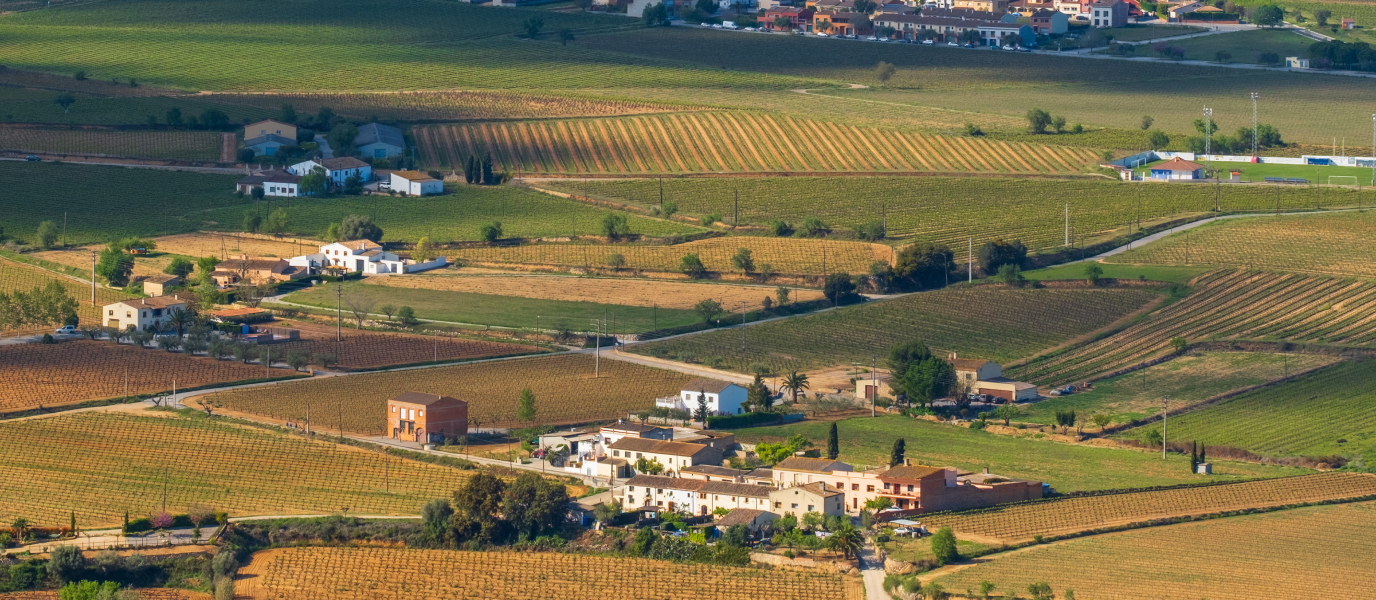
Vilafranca del Penedès, ciudad histórica y capital del vino y el cava
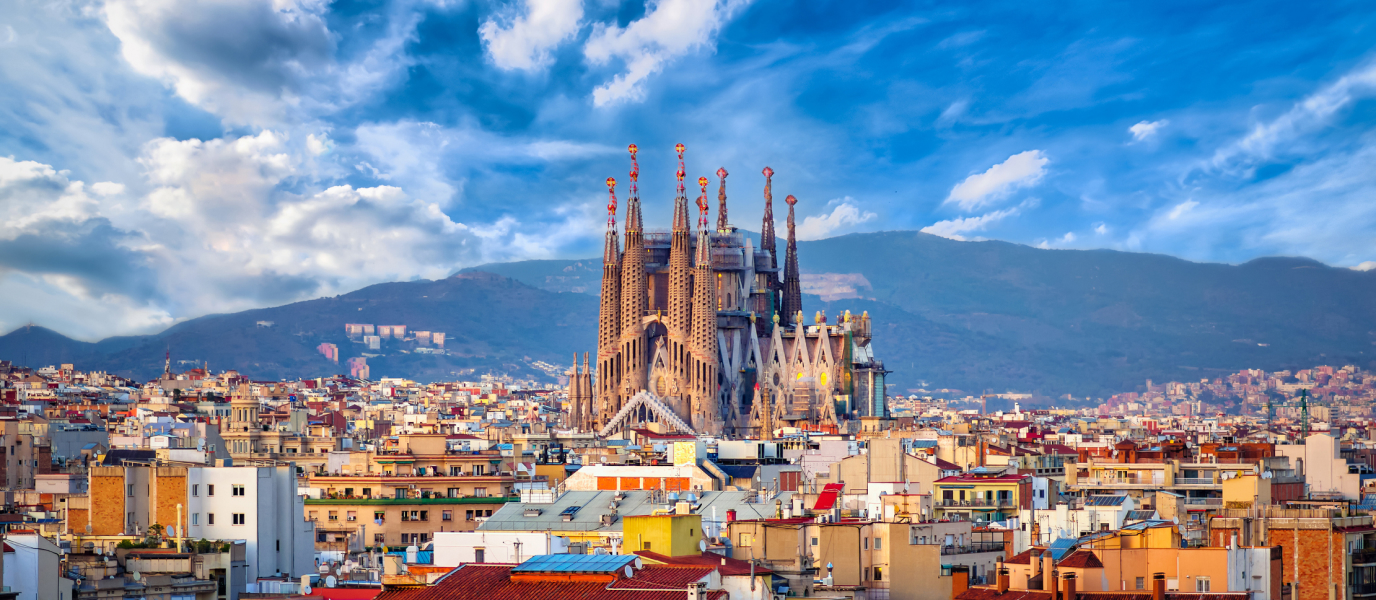
What to see in Barcelona: 36 essential things to do in the city
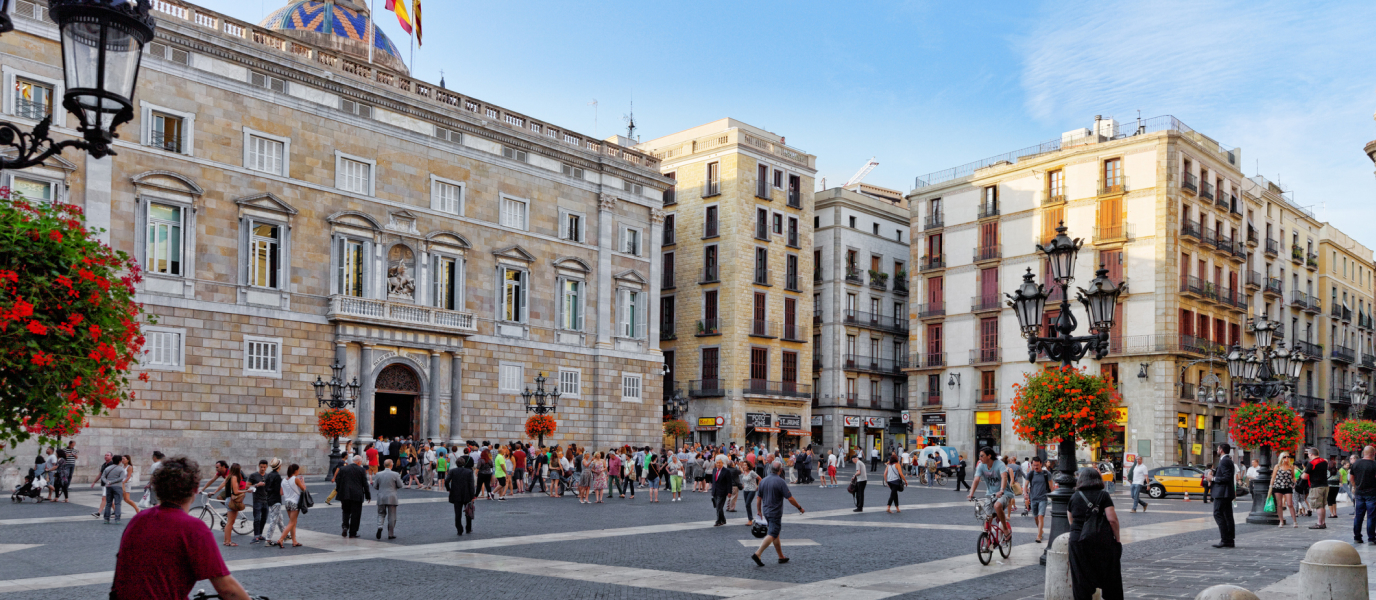
Plaça de Sant Jaume, a thousand-year-old icon of Catalan political power
The top 10 experiences.

Monthly gym and saunas bonus
from 40,00 €

Breakfast on the terrace at Occidental Diagonal 414
from 45,00 €

Cama Balinesa
from 60,00 €
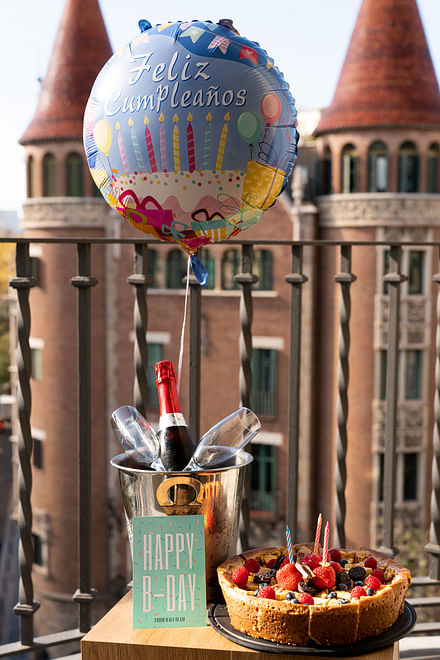
Celebrate your birthday in the room at Occidental Diagonal 414
from 65,00 €

Pool day and lunch
from 100,00 €
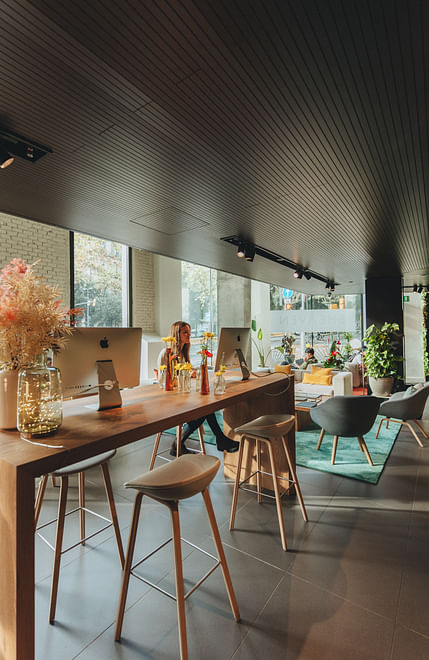
Working brunch en Occidental Diagonal 414
from 20,00 €

Combo and Football at Felipa Bar
from 16,00 €
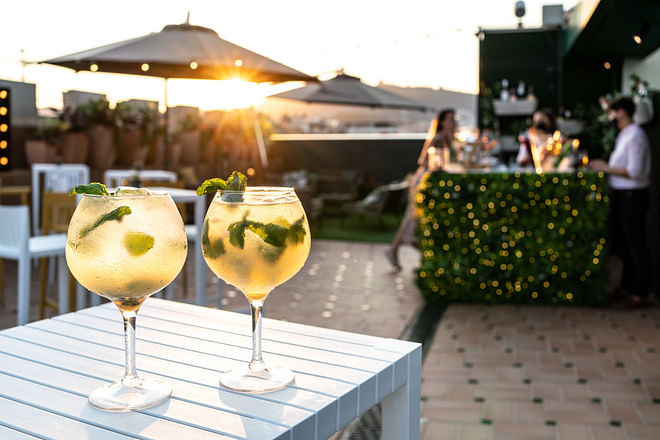
Afterwork en Occidental Diagonal 414
from 25,00 €

Montserrat, Tapas & Wine
from 79,95 €
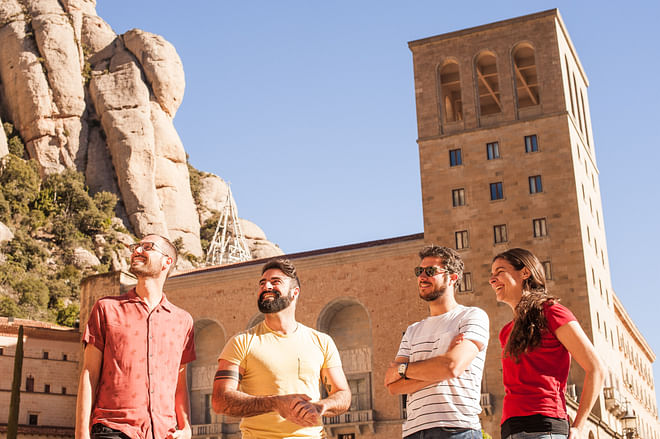
Montserrat, Food & Wine
from 99,95 €
Related plans
The capital of the Alt Penedès region offers a unique combination of rich architectural heritage and the finest wine and gastronomy.
Modernist buildings, parks, squares and museums are waiting for you to make your visit to Barcelona unforgettable. Here is a list of must-see places that you should not miss.
Located in the centre of the Gothic Quarter, where the Roman colony of Barcino emerged, this square has brought together Catalan political, social and religious life for two thousand years.
Discover Barcelona with our hotels
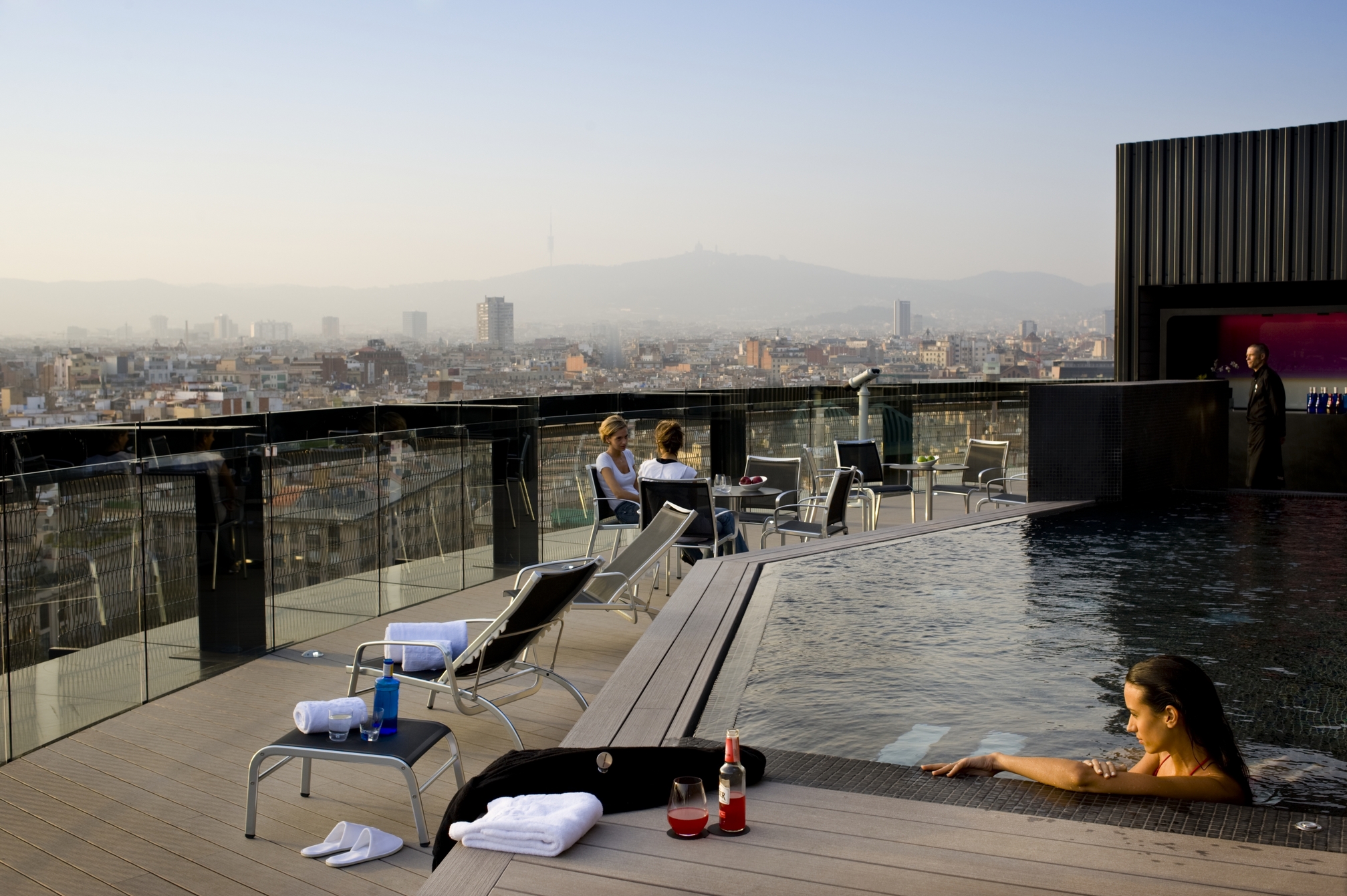
Barceló Raval
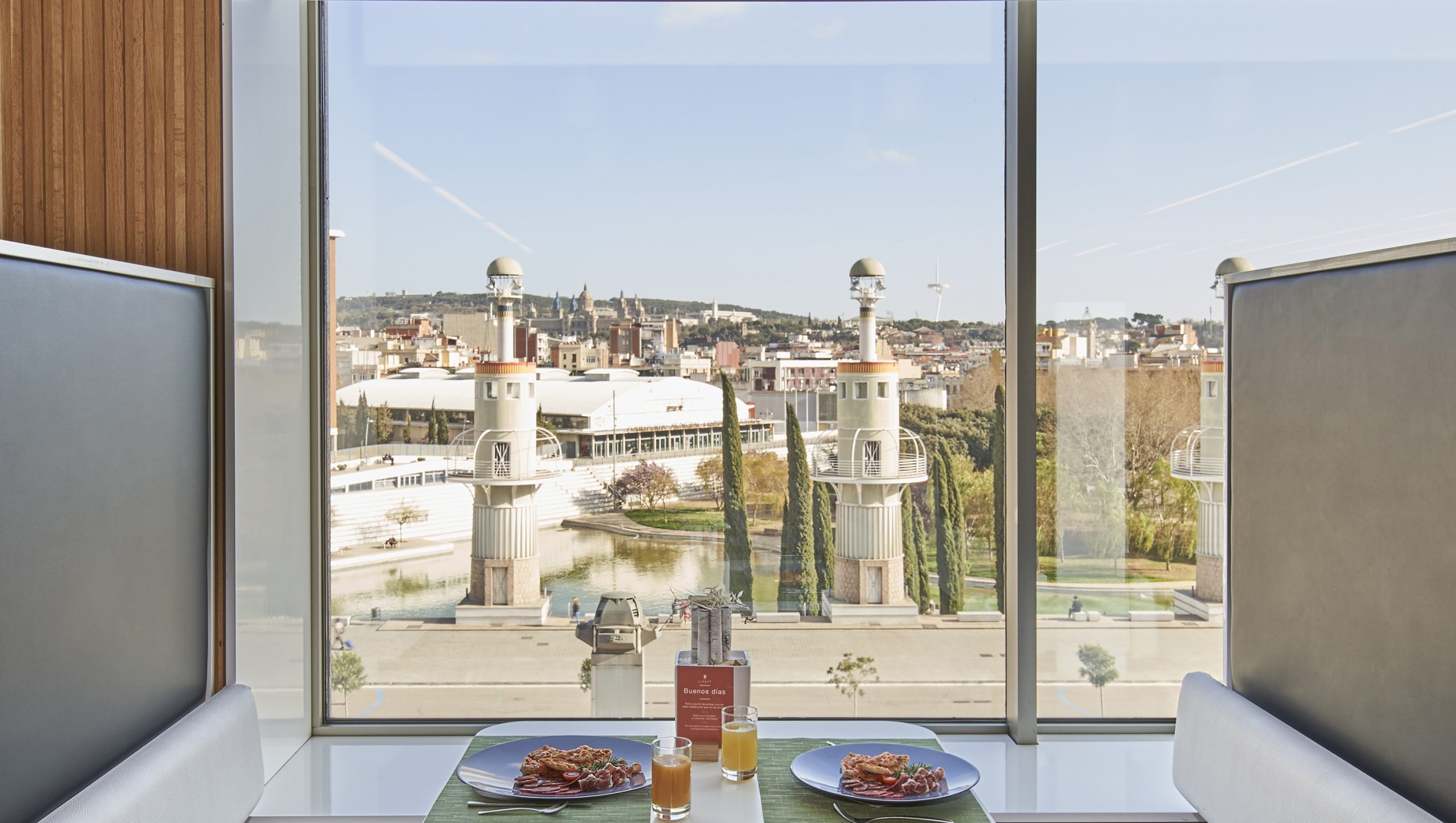
Barceló Sants
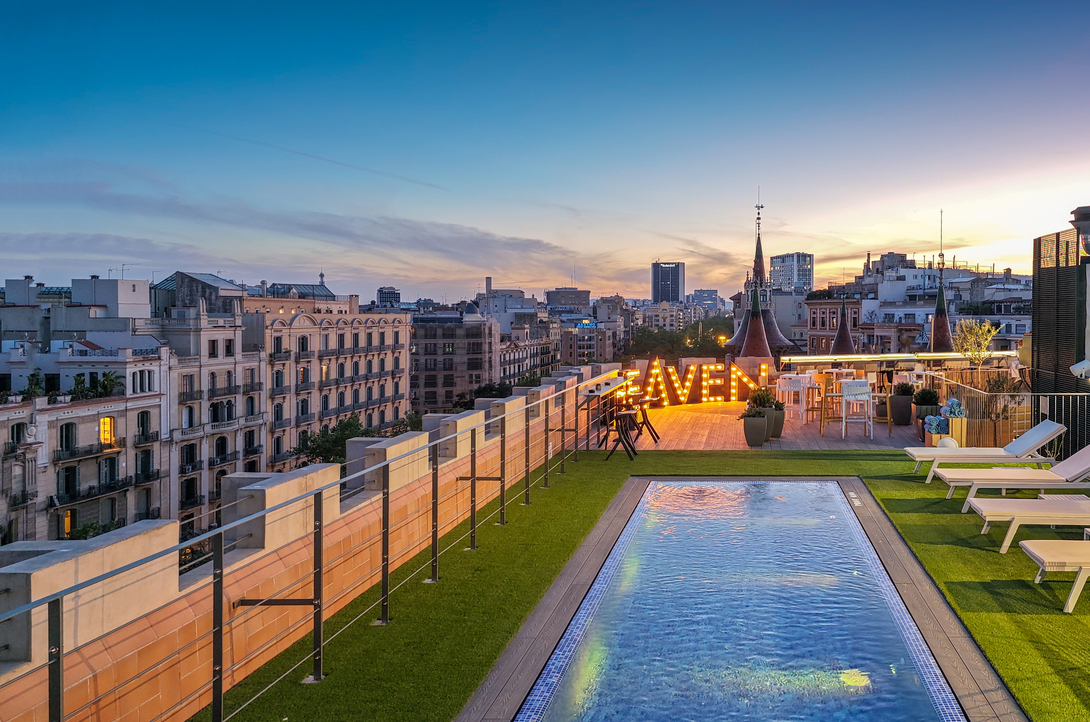
Occidental Diagonal 414
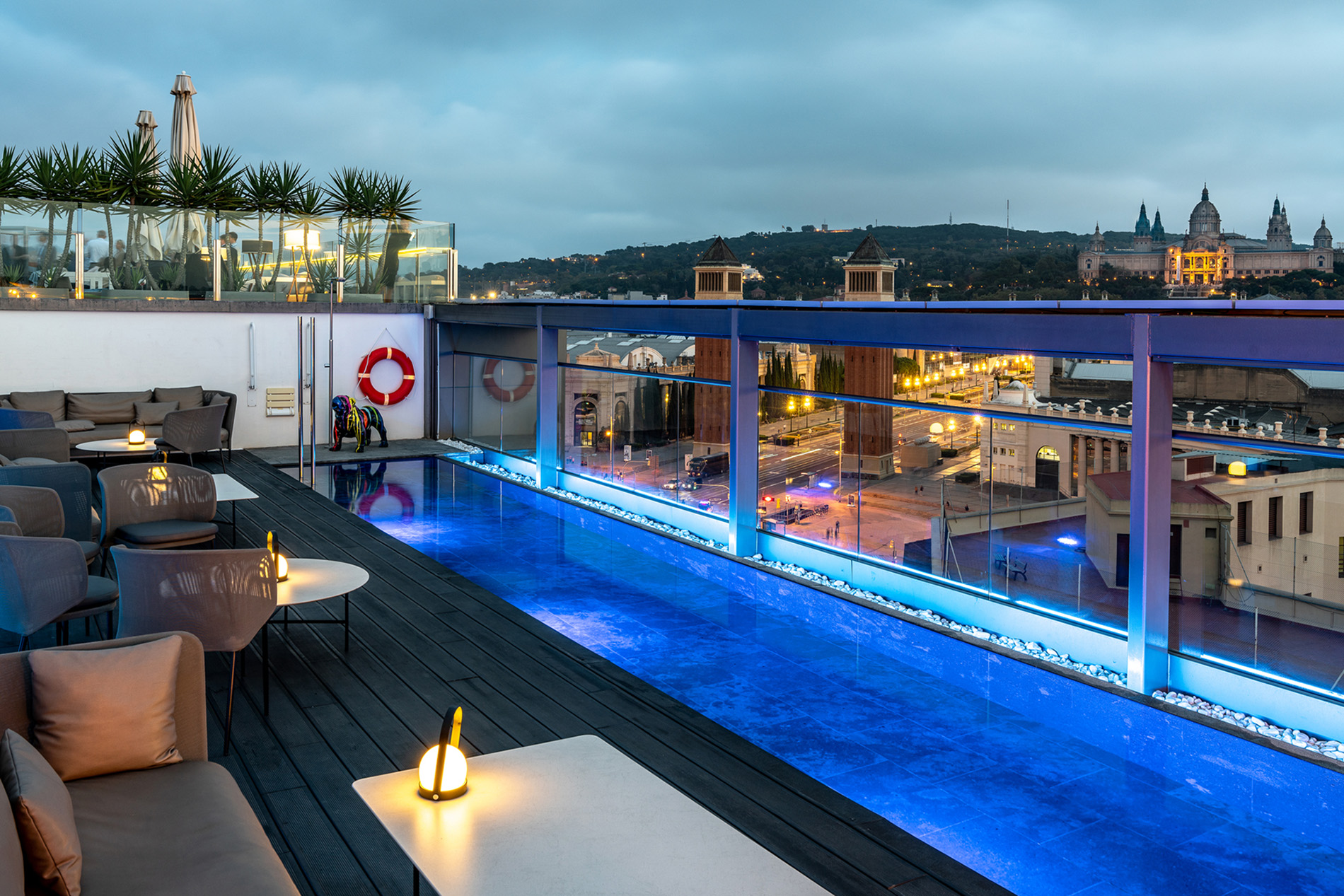
Occidental Barcelona 1929
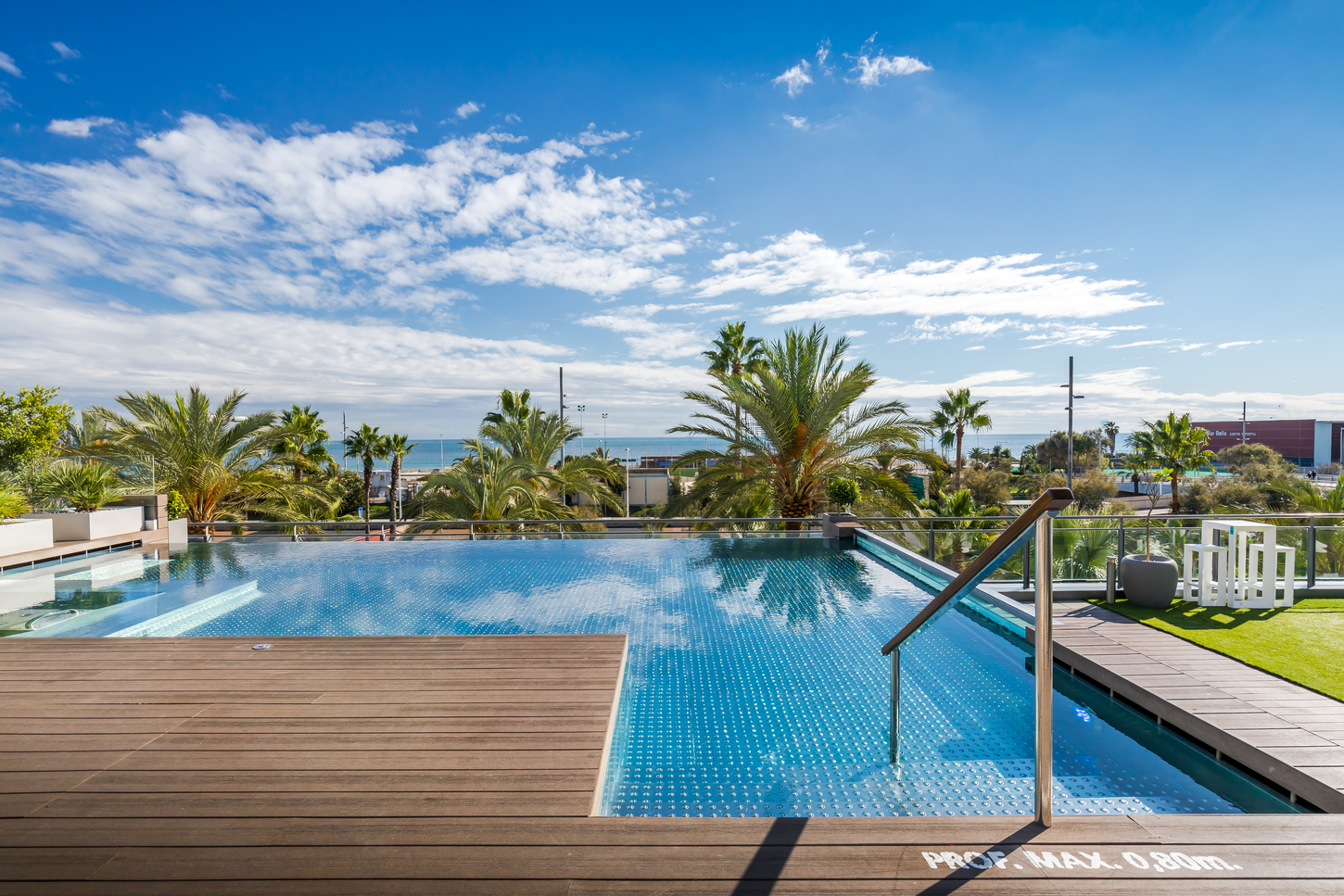
Occidental Atenea Mar
- Hébergement
- Attractions
- Manger et boire
- Se déplacer
- Apprendre l'espagnol
- Conseils de voyage
- Groupes & MICE
Torre Agbar Unveiled: Why it is a Must-Visit Attraction in Barcelona
Christian Petzold

Are you planning a trip to Barcelona and want to tick off all the must-visit attractions? Or are you a seasoned traveler seeking out hidden gems others might overlook?
Either way, I’ve got just the spot for you – Torre Agbar. Strap yourself in, my friend, because we are about to embark on an architectural journey that will leave you wanting more! In this article, I’ll unveil why Torre Agbar is a must-visit attraction in Barcelona.

Architectural Significance of Torre Agbar
The Torre Agbar – a landmark that’s hard to miss when you’re exploring the vibrant cityscape of Barcelona.
This high-rise tower, with its distinctive bullet-like shape and dazzling night light show, is a marvel of modern architecture that never fails to catch the eye. Designed by French architect Jean Nouvel, it was inspired by Montserrat, a mountain near Barcelona, and the unique shape of a geyser rising into the air. The humor here lies in how it has been lovingly nicknamed “the suppository” due to its unusual form!
The building’s architectural significance goes beyond just its peculiar design. At 144 meters tall (472 feet), it’s one of the tallest buildings in Barcelona and features an impressive 38 floors – 4 below ground and 34 above. But what sets this skyscraper apart is the technical feats hidden within:
- Eco-Friendly : It incorporates energy-saving technology like temperature sensors on exterior windows which adjust blinds based on sunlight intensity.
- Innovative Materials : Its facade consists of over 59 thousand pieces of aluminum and glass in different shades giving off an ever-changing color spectrum throughout each day.
- Cutting-edge structure : The reinforced concrete core provides stability while maintaining flexibility for office layouts – quite ingenious!
In conclusion, Torre Agbar isn’t just another pretty face; it’s also a symbolic figure for sustainable urban development. With all these advanced technologies simmering under its vibrant skin—akin to finding out your favorite comedian is also a Nobel laureate—it’s no wonder why this phallic-shaped edifice stands erect (no pun intended!) amidst other traditional architectures in Spain.
Intriguing History Behind Torre Agbar
Les Torre Agbar , a towering spectacle in Barcelona, has an intriguing history as vibrant as its nighttime light shows. Its unusual shape, often compared to a geyser shooting up into the sky or less flattering objects (let’s keep it PG here), was inspired by the Montserrat mountain range surrounding Barcelona and by the shape of a geyser rising into the air – hence the waterworks comparison.

Although some locals might cheekily argue that it bears more resemblance to… well, let’s say not everyone is thinking about geysers and mountains.
Constructed between 1999-2004, this architectural marvel designed by French architect Jean Nouvel boasts 34 floors of pure innovation. It houses offices (yeah, boring, I know), but wait till you hear this: they’re smartly designed for sustainability with temperature sensors controlling blinds and lights automatically.
Bullet List:
- The tower stands 144 meters tall. (That’s like stacking around 322 Danny DeVitos on top of each other!)
- It contains over 4,500 windows. (Perfect if you have nosy neighbors.)
What makes Torre Agbar stand out is its nocturnal allure. Fitted with over 4,000 LED devices that allow the generation of luminous images on its façade – it’s one giant game of Lite-Brite played out against the Barcelona skyline every evening!
With all those LEDs blinking away in a synchronized dance across its surface when night falls, Torre Agbar doesn’t just stand tall — it throws an epic disco party too!

Exploring the Interior of Torre Agbar: What to Expect
The moment you step inside the Torre Agbar , it’s like entering a different world. This isn’t just any ordinary skyscraper, oh no! You’ve got to imagine an exotic spacecraft from a sci-fi movie – only this one is real and located in Barcelona. Each floor has its unique charm, with the architects flexing their creative muscles to produce something truly out of this world.
First up, let’s talk about the lobby .
Now, don’t expect your usual reception desk and elevator setup here. Instead, you’re greeted by a vast expanse of space that looks more like an art gallery than a building entrance.
The walls are adorned with abstract artwork that could make Picasso green with envy! And then there’s the ceiling – or rather lack thereof – as it opens right up into the tower itself for all 34 floors to see!
- A tip : Don’t forget to look upwards; otherwise you might miss out on some jaw-dropping views.
Then we have the offices themselves .
Ever wanted an office room with panoramic views over Barcelona? Well, at Torre Agbar, they’ve got plenty! It’s enough to inspire anyone suffering from Monday blues or a mid-week crisis. Just looking outside can bring a sense of calmness during those stressful hours.
- Note : Desks near windows are hot property, so better stake your claim early!
Finally, we reach the crown jewel: the top-floor bar .
With a 360-degree view encompassing the city and sea, sipping cocktails here feels more like taking flight in “Aladdin’s magic carpet” than enjoying after-work drinks! Oh, if those cocktail glasses could talk…
- Friendly warning : Be careful not to get too lost in admiration though; remember you still need to find your way back down!
The Surrounding Neighborhood and Additional Attractions Near Torre Agbar
Step into the bustling neighborhood of Poblenou, and you’ll find yourself standing at the foot of the towering Torre Agbar .
This iconic skyscraper offers more than a jaw-dropping skyline view. It’s nestled in an area with enough attractions to fill your itinerary for days.
Firstly , stroll around this chic urban district and soak up its delightful mélange of old-world charm and modern innovation. You’ll encounter remnants from its industrial past sitting comfortably beside trendy coffee shops offering artisanal brews that could make even the most hardened coffee snobs weep with joy. But be forewarned – there’s a good chance you might stumble upon street musicians serenading passersby with tunes so catchy it makes resisting an impromptu dance incredibly challenging!
- The Rambla del Poblenou : A stone’s throw away from Torre Agbar is this vibrant boulevard lined with lush trees, quaint boutiques, and alfresco dining options serving mouth-watering local cuisine.
- The Mercat de la Unió : An authentic local market where fresh produce is piled high amidst a chorus of animated bargaining. If indulging in gastronomic adventures sounds like fun, this place will feel like heaven!
Lastly, step beyond Poblenou’s borders to explore Barcelona’s world-renowned attractions; Gaudi’s architectural marvels are just on your doorstep!
Fasten your seatbelts as you embark on an awe-inspiring journey through surreal landscapes created by one man’s unbridled imagination.
So if you thought visiting Torre Agbar was merely about gazing at an architectural wonder against Barcelona’s azure sky – think again! With plenty more gems hidden nearby, it would almost be criminal not to dig deeper into what can only be described as ‘Barcelona beyond Torre Agbar.’

The Torre Agbar, located in Barcelona, Spain, is a high-tech skyscraper known for its unique bullet shape and colorful night lighting. Designed by French architect Jean Nouvel, it’s an iconic symbol of modern Spanish architecture and houses various offices, including the Barcelona Water Company.
Foire aux questions (FAQ)
The Torre Agbar is a unique skyscraper located in Barcelona, Spain. It was designed by French architect Jean Nouvel and Spanish firm b720 Fermin Vazquez Arquitectos. The building’s distinctive design was inspired by the Montserrat mountain range and the shape of a geyser rising into the air.
Construction on the Torre Agbar began in 1999, and it officially opened its doors in 2005. The tower took six years due to its intricate design features, including over 4,000 windows and an advanced temperature regulation system.
The Torre Agbar stands at an impressive height of 144 meters (472 feet). With this height, it boasts of being one of the tallest buildings in Barcelona. It has 38 floors, with thirty-four above ground level for office spaces and four below for parking.
Torre Agbar offers an unforgettable spectacle when night falls thanks to its innovative lighting system comprising more than 4,500 LED devices that can operate independently using software capable of creating varied light patterns on its facade – from smooth transitions across a spectrum of colors to simulating movement or visual images.
Unfortunately not; although it’s a fascinating piece of architecture visually, especially during nighttime illumination, public access within isn’t available as it currently serves as private office space.
“The Torre Agbar, from a distance, is like a geyser under permanent high pressure and made of the same water that it spouts.” — Unknown
“It’s not an emblematic skyscraper but rather one that wants to make friends with its surroundings.” — Unknown
“Torre Agbar represents energy; it is an urban signal within the city.” — Unknown
Le saviez-vous ?
Torre Agbar, a symbol of Barcelona, soars high with its unique bullet-shaped structure. This architectural marvel is not just another skyscraper; it boasts 4500 windows that reflect the city’s vibrant life during the day and illuminate to form an enchanting light show at night. Jean Nouvel, the creative mind behind this masterpiece, found his inspiration in the Montserrat mountain range surrounding Barcelona. The tower’s design mimics nature, with its rocky cliffs and valleys forming a vertical landscape. Despite its futuristic appearance, Torre Agbar pays homage to Catalan culture. Its outer layer resembles typical Mediterranean blinds used across Spain for centuries – a nod to tradition amid modernity.
Dive into the captivating tales of Pere Milà et Josep Batlló , while embarking on an enchanting journey through the Gaudí Experience . Explore the artistic marvels and architectural wonders that define their legacies in this immersive guide.
Laisser un commentaire Annuler la réponse
Votre adresse e-mail ne sera pas publiée. Les champs obligatoires sont indiqués avec *
- Random Project
- Collaborate
Agbar Tower
Introduction, floors above ground.
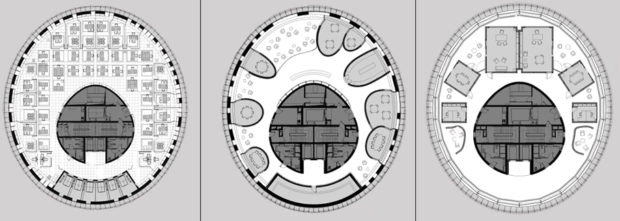
- The offices provide completely free of columns surfaces
- Ceiling Height 2.60m
- Raised floor encapsulated with 15cm height free and finished in galvanized steel, supporting 1.500kg/m2 overload.
- False ceiling plate making galvanized soundproof interior and concealed
- Luminaires recessed ceiling lighting and direct traffic areas and elevator lobbies. Emergency lighting. Spark lighting by motion detectors.
- Centralized fire detection system. Sprinklers in the ceiling.
- Furniture for integrated facade modules.
- Fixed and casement windows.
- Voice-data wiring and electrical boxes installed under the floor and perimeter facade socket.
- Kitchen -office per floor.
Underground Floors
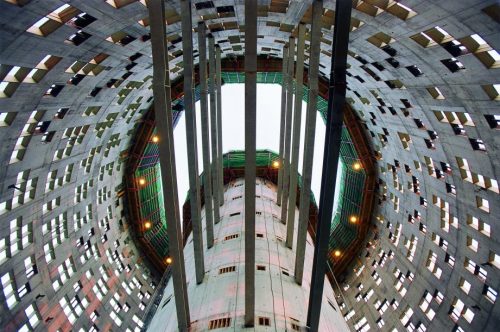
Respect to the environment
- The building has temperature sensors in the outside regulating the opening and closing of the glass blinds of the facade, reducing the consumption of energy required for air conditioning.
- In order to reduce energy consumption and achieve natural ventilation have been designed 4,500 windows, plus ventilation, allow the use of natural light. Air circulation is regulated through the dome with double glazing.
- In its construction have not used materials containing formaldehyde, asbestos or lead in paints.
- Formation of a cavity between the two skins covering the building reduce overheating, favoring ventilation.
- Through a computer system is optimized travel lifts, avoiding unnecessary consumption.
- We have allocated spaces for bicycle parking.
- The proportion of energy gains relative to the incident solar radiation reaches a mean value of 25.11%. Free of chlorofluorocarbons refrigerants materials are used to avoid damaging the ozone layer.
- The groundwater are used for cleaning floors and ornamentation.
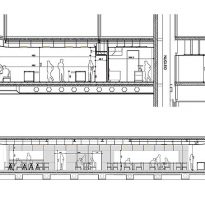
En construcción
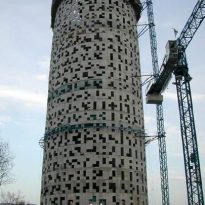
Fotos WikiArquitectura (Noviembre 2013)
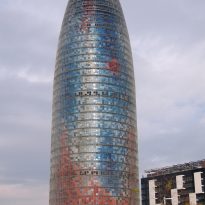
Did you find this article useful?
Really sorry to hear that...
Help us improve. How can we make this article better?

- Fr Français
Torre Agbar
- Barcelona, Spain
- Full screen
This is not a tower
This is not a tower, a skyscraper, in the American sense. It is a more an emergence, rising singularly in the center of a generally calm city. Unlike slender spires and bell towers that typically pierce the horizons of horizontal cities, this tower is a fluid mass that bursts through the ground like a geyser under permanent, calculated pressure.
The surface of the building evokes water: smooth and continuous, shimmering and transparent, its materials reveal themselves in nuanced shades of color and light. It is architecture of the earth without the heaviness of stone, like a distant echo of old Catalan formal obsessions carried by a mysterious wind off the Monserrat.
The ambiguities of material and light make the Agbar tower resonate against Barcelona’s skyline day and night, like a distant mirage, marking the entry into the diagonal avenue from the Plaça de les Glorias. This singular object will become the new symbol of Barcelona the international city, and become one of its best ambassadors.
Jean Nouvel
- Add the project to my selection
- View my selection
Visiter Barcelone
Tout pour passer un séjour inoubliable en 2024 !
La tour Agbar : un chef-d’œuvre d’architecture moderne
22/12/2022 By Thibaut Laisser un commentaire
La tour Agbar est sans aucun doute l’un des bâtiments les plus emblématiques et les plus connus de Barcelone.
En plus d’être un monument de renommée mondiale, ce bâtiment est l’un des plus visités par les habitants et les voyageurs.
Je vous emmène la découvrir !
La tour Agbar : sommaire de l’article
- Histoire de la Tour Agbar à Barcelone
- Combien coûte l’ascension de la Tour Agbar ?
- Où manger près de la Tour Agbar ?
- Que visiter aux alentours de la Tour Agbar ?
- Comment se rendre à la Tour Agbar ?
- A quelle heure allument-ils la Tour Agbar ?
Histoire de la tour Agbar à Barcelone
La tour Agbar, dont le nom est un acronyme pour Aigües de Barcelona , a été construite en 2005 et se trouve sur l’Avenida Diagonal. Cette structure impressionnante compte 34 étages, atteignant une hauteur de plus de 145 mètres. Avec une taille pareille, vous pouvez la voir de presque n’importe où dans la ville.
Cette tour, créée par le célèbre architecte français Jean Nouvel , a une structure particulière en forme de balle, inspiré des sommets de la montagne de Montserrat. N’importe quel moment de la journée est un bon moment pour visiter ce monument, bien que je vous recommande de le visiter la nuit, lorsque la tour est illuminée de différentes couleurs, créant un véritable spectacle visuel .
Sur le plan architectural, la tour est un chef-d’œuvre. Sa façade se constitue de lamelles de verre orientables, chacune de couleur différente. Cette tour marque l’entrée du technopôle de la ville de Barcelone, partageant l’espace avec certaines des entreprises les plus technologiquement avancées de la région.
Combien coûte l’ascension de la tour Agbar ?
Il n’est actuellement pas possible de visiter l’intérieur, car il est en cours de reconversion. En effet, elle sera bientôt convertie en hôtel de luxe.

Où manger près de la tour Agbar ?
Lorsque vous avez terminé de prendre vos photos près de la tour Agbar, vous pourrez profiter d’ un agréable déjeuner ou dîner dans l’un des nombreux restaurants de la région.
Si vous aimez la cuisine chinoise, vous devez absolument visiter le restaurant Pai Mei Glories . Dégustez des plats asiatiques créés de toutes pièces en fonction de vos goûts, le tout à distance de marche de la tour !
Une autre option est le merveilleux restaurant Novotel , où vous pourrez déguster une variété de plats dans un cadre idyllique avec vue sur la tour Agbar. De plus, sur place, vous profitez d’un excellent rapport qualité/prix.
Enfin, je vous recommande d’essayer le restaurant GreenVita Glòries , où vous pourrez déguster différents types de plats sains, ainsi que leurs incroyables desserts, à une courte distance de la tour.
Que visiter aux alentours de la tour Agbar ?
Située au cœur de la ville, la tour peut également être le point de départ de vos visites . Ainsi, il y a de nombreuses choses à voir à proximité de cette dernière.
Palau de la Música Catalana
Bien qu’il ne soit pas particulièrement proche, vous ne pouvez pas manquer une visite à la Palau de la Música Catalana après votre visite à la tour. Que vous assistiez à l’un de ses spectacles musicaux ou que vous fassiez simplement une visite guidée de l’édifice, vous serez certainement émerveillé par la beauté de la Palau !
La Sagrada Familia
La Sagrada Familia est l’un des endroits les plus importants à visiter à Barcelone, située à seulement 20 minutes à pied de la tour. C’est sans aucun doute l’une des œuvres les plus emblématiques du célèbre architecte Gaudí .
Vous serez fasciné par sa beauté architecturale, ses couleurs et sa décoration. Vous pouvez aussi visiter son intérieur et monter dans la partie la plus élevée du lieu, où vous pourrez profiter de vues spectaculaires sur la ville. Pour découvrir tous les détails sur ce lieu, n’hésitez pas à lire mon article sur le sujet.
L’hôpital de la Santa Creu i Sant Pau
Un autre incontournable est l’hôpital de la Santa Creu i Sant Pau , à seulement 20 minutes. Cet impressionnant bâtiment propose une visite de deux heures, dont vous pouvez profiter gratuitement le premier dimanche de chaque mois. À ne pas manquer !
Comment se rendre à la tour Agbar ?
Vous pouvez vous rendre à la tour Agbar par différents moyens de transport depuis n’importe où à Barcelone.
Vous pouvez vous y rendre en métro , plus précisément par la ligne 1 et en descendant à l’arrêt Glòries.
Une autre option est de prendre le bus , sur les lignes 7, g0, 92, 192 ou H12.
Enfin, vous pouvez prendre le tram grâce à la ligne 4 et descendre à l’arrêt Glòries.
À quelle heure allument-ils la tour ?
L’éclairage de la tour Agbar varie en fonction de la période de l’année. Si vous visitez Barcelone pendant l’été, les lumières sont allumées de 21 h à minuit les vendredis, samedis et dimanches.
En revanche, si vous visitez la ville en hiver, les lumières s’allument de 20 h à 23 h.
Vous en savez maintenant plus sur cette tour emblématique de Barcelone. Lors de votre visite, je vous conseille de passer sur les lieux. Vous pourrez profiter de la beauté de l’édifice pour prendre quelques photos !
Que faire à Barcelone en 1 jour, en 2 jours, en 3 jours, en 5 jours, en une semaine ?
Quelque soit la durée de votre séjour, je vous invite à télécharger mon guide spécial Barcelone.
Il est gratuit et se présente sous format PDF.
Vous devez simplement m'indiquer ci-dessous à quelle adresse email vous voulez le recevoir.
EDIT: vous n'arrivez pas à inscrire votre email ?
Répondez au quizz tout en haut de cet article et vous pourrez inscrire votre email pour recevoir le guide spécial Barcelone !
À propos Thibaut
J'aide les voyageurs à mieux visiter la ville de Barcelone avec un contenu écrit et actualisé par des experts locaux pour vivre la meilleure expérience possible ! Notre agence de voyage propose également des visites guidées en français.
Laisser un commentaire Annuler la réponse
Votre adresse e-mail ne sera pas publiée. Les champs obligatoires sont indiqués avec *
Commentaire *


ABONNEZ-VOUS À NOTRE NEWSLETTER
+212 6 69 08 79 45
- Gestion de projet
- Architecture
- Usine industriel
- Design interieur
À propos de nous
Nous concevons des projets sur-mesure en architecture et urbanisme, en harmonie avec votre environnement et vos besoins. Nos professionnels expérimentés travaillent avec vous pour réaliser votre projet de rêve.
Contact Info
N° 8, 33 rue El Mansour Eddahabi, 3ème Etage, Tangier 90000

La majestueuse Tour Akbar de Barcelone se dresse comme un phare architectural, fusionnant avec élégance l’histoire ancienne et le design contemporain. Conçue par l’éminent architecte espagnol Alejandro Martínez, cette tour emblématique a été inaugurée en 2021 et est rapidement devenue une icône du paysage urbain catalan.
S’élevant à une hauteur vertigineuse de 300 mètres, la Tour Akbar est une prouesse technique qui marie harmonieusement des éléments traditionnels de l’architecture catalane avec des innovations modernes. Les motifs géométriques complexes de style mauresque ornent les façades, créant une symbiose visuelle avec les lignes épurées et les surfaces en verre contemporaines. Enracinée dans le tissu culturel de la ville, la Tour Akbar devient un point de rencontre dynamique pour les citoyens et les visiteurs. Les espaces publics en bas de la tour accueillent des événements artistiques et culturels, tandis que les jardins paysagers offrent un havre de paix au cœur de l’effervescence urbaine.
La Tour Akbar incarne véritablement la capacité de l’architecture à transcender le temps, reliant le passé et le futur dans un écrin captivant. C’est un témoignage audacieux de la vision créative de Barcelone et de son engagement envers l’innovation, élevant la ville à de nouveaux sommets architecturaux et culturels.
- Places - Siberia and the Russian Far East
Russian Far East
The Russian Far East is a region in eastern Russia that includes the territories that run along the Pacific coast and the Amur River, the Kamchatka Peninsula, Sakhalin island and the Kuril Islands. It is a cold, inhospitable and sparsely populated area with stunning scenery, rich fisheries, virgin forest, remote towns, Siberian tigers and Aumur leopards. Sometimes the Russian Far East is regarded as part of Siberia.
Rachel Dickinson wrote in The Atlantic: Russia’s Far Eastern Federal District is huge — 2.4 million square miles, roughly twice the size of India — and takes up one-third of the country, but only 6.7 million people populate that vast space. (The district’s biggest city is Vladivostok — best known for being the last stop on the Trans-Siberian Railroad and home to the Russian Pacific fleet.) Provideniya was once a thriving military town with a population as high as 10,000; today the population is about 2,000. Most of the ethnic Russians have left, ceding the city to the region’s indigenous people. Now the government is struggling to stem the tide of people leaving the desolate Far East. [Source: Rachel Dickinson, The Atlantic, July/August 2009]
The entire Russian Pacific coastline extends for almost 16,000 kilometers (10,000 miles). The formal dividing line between Siberia and the Far East are the borders of the Khabarovsk territory and Magadan region, which extends between 160 kilometers (100 miles) to 1,600 kilometers (1,000 miles) inland from the Russia's east coast. Siberia, the Russian Far East and Kamchatka were largely covered by glaciers during the last Ice Age, which ended about 10,000 years ago. In the Soviet era, the Far East had its share of gulags and labor camps, Maksim Gorky called it " land of chains and ice." Since the break up of the Soviet Union, its people have largely been forgotten. The whole region would probably be forgotten if it weren't so rich in resources.
The Far East only has 6.7 million people and its population is falling. There used to be around 8 million people there. Eighty percent of the people live in the cities but have a strong ties to the land: hunting, fishing or picking berries and mushrooms whenever they get the chance. Some places only exist because the government subsidizes them, providing the people with shipped-in food and cheap energy for heat. In the early 2000s, the government has decided it has spent too much supporting these people and told them they have to move. In some places the people refused to move and the government cut off their water and heat and they still stayed. In recent years thing have stabilized somewhat as more money has flowed in from oil, natural gas, minerals, fishing and timber.
What the Russian Far East lacks in historical sites, old cities and museums — compared to the European parts of Russia and even Siberia — it makes up for with a wide variety of beautiful scenery and adventures. The Amur Rive boast sturgeons the size of whales. In the Primorskiy territory you can find rocky islands, steep cliffs, Siberian tigers and Amur leopards. There are isolated beaches on rivers and the see. If you like taiga, there lots of that along with wild mountains and many places to go hiking, fishing, hunting and camping. On Kamchatka there are dozens of very active 's volcanoes. Further north are some of the best places in the world to see walruses, polar bears and whales. Khabarovsk and Vladivostok are two major cities that define the eastern end of the Trans-Siberian Railway and have plenty of urban activities.
The Far Eastern Federal District is the largest of the eight federal districts of Russia but the least populated. The 11 federal subjects are: 1) Amur Oblast: 361,900 square kilometers, 830,103 people, capital: Blagoveshchensk 2) Republic of Buryatia: 351,300 square kilometers,, 971,021 people, capital: Ulan-Ude 3) Jewish Autonomous Oblast: 36,300 square kilometers, 176,558 people, capital: Birobidzhan 4) Zabaykalsky Krai: 431,900 square kilometers, 1,107,107 people, capital: Chita 5) Kamchatka Krai: 464,300 square kilometers, 322,079 people, capital: Petropavlovsk-Kamchatsky 6) Magadan Oblast: 462,500 square kilometers, 156,996 people, capital: Magadan 7) Primorsky Krai: 164,700 square kilometers, 1,956,497 people, capital: Vladivostok 8) Sakha Republic: 3,083,500 square kilometers, 958,528, people capital: Yakutsk 9) Sakhalin Oblast: 87,100 square kilometers, 497,973 people, capital: Yuzhno-Sakhalinsk 10) Khabarovsk Krai: 787,600 square kilometers, 1,343,869 people, capital: Khabarovsk 11) Chukotka Autonomous Okrug: 721,500 square kilometers, 50,526 people, capital: Anadyr
Traveling in the Far East is troublesome. There are few roads, and they are in poor conditions. Many places can’t be reached by road anyway. Rivers are frozen much of the year. Helicopters can cost as much as US$500 an hour to rent. Corruption is rampant and it seems like everyone wants a cut. Even if paperwork is in order customs officials, police an other authorities demand, sometimes, huge outrageous "fees."
Economics of the Far East
The Far East is rich in gold, diamonds, oil, natural gas, minerals, timber and fish. It accounts for more than 60 percent of Russia's total sea harvest and fishing is the region’s leading industry, providing jobs for more than 150,000 people. People in the Far East should be rich from the wealth generated from fishing, timber and minerals but that is not necessarily the case. In the case of timber, in the early 2000s, local communities were supposed to get 30 percent of the profits but in reality Moscow took 80 percent and local officials took the rest.
In the early 2000s, gas and oil companies could not pay their workers and utility companies couldn’t pay the oil and gas companies and as a result electricity was only on for a few hours a day. Workers were among the last to receive their wages, factories were cannibalized of scrap metal and parts, students studied in sub-freezing classrooms, and people died at early ages. Those that could afford it moved away.
Many foreign companies were equally frustrated. The U.S. wood product giant Weyerhaueser, Korea's Hyundai conglomerate and Australian mining companies arrived in east Russia with high hopes but after some time there either packed up and left or scaled down their staff down to a skeletal crew.
Ussuri River
The Ussuri River forms the border between Russia and China in southern Khabarovsk Krai and . Primorsky Karia. A right tributary of the Amur, it is 897 kilometers long, with a basin area of more than 193,000 square kilometers. The Ussuri River originates in the spurs of the central Sikhote-Alin. Once it descends into it the valley, the river becomes flat and gentle but has a steep rocky coast. In many area there are meandering channels.
Among the tributaries of the Ussuri are: 1) the upper river: Izvilinka, Sokolovka, Matveyevka and Pavlivka. 2) the left tributaries: Arsen'evka, Muling, Naoli River and Songacha River; 3) and the right tributaries: Pavlovka, Zhuravlovka, Big Ussurka, Bikin and Khor.
In Khabarovsk Krai, near the village of Kazakevichevo, Ussuri River flows into the shallow Kazakevichevo channel and after that the confluence of the Ussuri is called the Amur channel. The Amur channel empties into the Amur River in the center of the city of Khabarovsk. The Ussuri is a full-flowing river from May to August. In the summer and when the ice breaks there are frequent floods. Ice on the Ussuri breaks up in April and forms in November. The water is used for water supply. Above Lesozavodsk the river is navigable. Previously it was widely used for timber floating.
The Ussuri River is good for fishing and rich in fish. Gudgeon, crucian carp, common carp, trout, burbot, pike, catfish, flax and grayling are all caught as are Kaluga sturgeon, which can reach a huge size (eight meters recorded in the Amur River). The river is a spawning ground for salmon and chum salmon. In the waters of the Ussuri fish mountain rivers are found near the bottom fish. Mountain fish comes to the Ussuri in the spring to spawn.
Ussuri Taiga and Dersu Uzala
The Ussuri taiga is a forest different from the normal Russian taiga. Located between the Ussuri and Amur Rivers in the Far East and dominated by the Sikhot Alim Mountains, it is a monsoon forest filled with plants and animals found nowhere else in Siberia or Russia and instead are similar to those found in China, Korea and even the Himalayas. In the forest there is s lush undergrowth, with lianas and ferns. Wildlife include Siberian tigers, Asian black bears, Amur leopards and even tree frogs. The Siberian Tiger Project is located here. The 1970 Akira Kurosawa Oscar-winning film “Dersu Uzala,” and the book it was based on, about a Tungus trapper, was set here.
Ian Frazier wrote in The New Yorker: ““Dersu Uzala,” the memoir and narrative of exploration by Vladimir K. Arsenyev, begins in 1902, when Arsenyev is a young Army officer assigned the job of exploring and mapping the almost unknown regions east and northeast of Vladivostok, including Lake Khanka and the upper watershed of the Ussuri River. The name for the whole area is the Primorskii Krai—the By-the-Sea Region. It and much of the Khabarovskii Krai, just to the north of it, consist of a unique kind of Pacific forest in which tall hardwoods hung with vines grow beside conifers almost equally high, and the lushness of the foliage, especially along the watercourses, often becomes quite jungly. [Source: Ian Frazier, The New Yorker, August 10 and 17, 2009, Frazier is author of “Travels in Siberia” (2010) ]
“In Arsenyev’s time, this jungle-taiga was full of wildlife, with species ranging from the flying squirrel and the wild boar to the Siberian tiger. Back then (and even recently) tigers could also be seen on the outskirts of Vladivostok, where they sometimes made forays to kill and carry off dogs. Arsenyev describes how tigers in the forest sometimes bellowed like red deer to attract the deer during mating season; the tiger’s imitation betrayed itself only at the end of the bellow, when it trailed off into a purr.
“The humans one was likely to meet in this nearly trackless forest were Chinese medicine hunters, bandits, inhabitants of little Korean settlements, and hunter-trappers of wild game. Dersu Uzala, a trapper whom Arsenyev and his men come upon early in their 1902 journey, is a Siberian native of the Nanai tribe whose wife and children have died of smallpox and who now is alone. After their meeting, Dersu becomes the party’s guide. The book is about Arsenyev’s adventures with Dersu on this journey and others, their friendship, and Dersu’s decline and end.
“In the nineteen-seventies, a Soviet film studio produced a movie of “Dersu Uzala,” directed by Akira Kurosawa. It won the Academy Award for Best Foreign Film of 1975. The movie is long and slow-paced, like a passage through the forest, and wonderfully evokes the Primorskii country. I own a cassette of the movie and in my many viewings of it even picked up some useful fractured Russian from the distinctive way Dersu talks.
Udegeh: People Who Live with Siberian Tigers
The Udegeh live around the Sikhotealin Mountains in the Far East, also home to many Siberian tigers, and traditionally survived by hunting in the forest. Their ancestors were farmers and members of the Zhurdzhen empire, which ruled parts of what is now China, Mongolia and Russia. In the 13th century, Zhurdzhen was defeated by Genghis Khan and the Mongols and survived in scattered communities in the forest, where they became nomadic hunters to survive and formed their own language and culture, called Udegeh. There are only about 2,000 Udegeh left. The largest group lives in a village called Krasnyr, about 175 miles southeast of Khabarovsk.
The Udegeh live in wooden houses that often have painted gables with images of bears, dogs, devils and pagan goddesses. Their villages are surrounded by forests, and in the winter deep snow. They primarily live on animals they hunt such as sable, mink, squirrel, deer and boar. They often earn what little money they have by collecting wild ginseng in the forest or selling furs.
About 80 Siberian tigers live in the Udegeh hunting grounds. The Udegeh worship tigers, which are considered sinful to kill. One Udegeh hunter told the Washington Post, "The tiger and the Udegeh people are the same."
In the 1920s, the Udegeh were organized into hunting cooperatives by the Soviets. They sold furs to the Soviets and were able to keep their culture alive even though the Communists frowned upon their pagan beliefs and shaman practices. Today most young Udegeh wear Russian clothes and few of them speak the old language. Intermarriage is common and there are few pure blood Udegeh left. In the early 1990s, the Udegeh were involved in a dispute with the South Korean conglomerate Hyundai, who wanted to log the Udegeh's hunting ground.
See Separate Article PEOPLE OF THE RUSSIAN FAR EAST factsanddetails.com
Ussuriisk (kilometer 9177 on the Trans-Siberian, an hour and a half drive from Vladivostok) contains a "Chinese Bazaar" that is more like a separate town. The market operates all night and approximately 2,000 Chinese traders live semi-permanently in metal freight containers near their stalls.
The Museum of History and Local Lore and the famous 800-year-old stone turtle will introduce you to the history of this city. At the end of summer, tourists come to see the city's blooming lotuses. In the winter, you can enjoy a swim in an outdoor pool, surrounded by snowy fir trees. There is a historical park of everyday life and customs of the Russian people called “Emerald Valley” located five kilometers away from the city . Various events are held here, including the celebration of Kupala Night, jousting tournaments, Christmas and Maslenitsa festivities.
Ussuriisk is located near the border with China and North Korea and stands at the confluence of the Komarovka, Rakovka and Razdolnaya. The city was founded in 1866 by Russians from Voronezh and Astrakhan province in East Russia and the Capian Sea area. The town began to grow when the construction of the Trans-Siberian Railway began in the area.
Places Where the Siberian Tigers Live
Siberian tigers today are confined primarily to the Ussuri Taiga, a forest different from the normal Russian taiga. Located between the Ussuri and Amur Rivers in the Far East and dominated by the Sikhot Alim Mountains, it is a monsoon forest filled with plants and animals found nowhere else in Siberia or Russia and instead are similar to those found in China, Korea and even the Himalayas. In the forest there is s lush undergrowth, with lianas and ferns. Wildlife include Siberian tigers, Asian black bears, Amur leopards and even tree frogs. The Siberian Tiger Project is located here. The 1970 Akira Kurosawa film Dersu Uzala, about a Tungus trapper, was set here.
Sikhot Alin Reserve and Kedrovaya Pad Reserve within the Ussuri Taiga are the last homes of the Siberian tiger. The largest wildlife sanctuaries in the Far East, they embrace 1,350 square miles of forested mountains, coastline and clear rivers. Other animals found in Sikhot Alin reserve and Kedrovaya Pad reserve include brown bears, Amur leopard (of which only 20 to 30 remain), the Manchurian deer, roe deer, goral (a rare mountain goat), Asian black bears, salmon, lynx, wolf and squirrels with tassels on their ears, azure winged magpies and the emerald-colored papilio bianor maackii butterfly. Over 350 different species of bird have been sen here.
Dunishenko and Kulikov wrote: “In the 19th century, aside from the Sikhote-Alin and Malyi Khingan portions of Russia, tigers were found in southeastern Transcaucasia, in the Balkhash basin, in Iran, China and Korea. Now the Amur tiger is found only in Russia’s Primorskii and southern Khabarovskii Krais. This is all that remains of an enormous tiger population that formerly numbered in the thousands and that lived mostly in China. In the spring of 1998, one of the authors of this booklet took part in an international scientific study investigating the best tiger habitat remaining in the Chinese province of Jilin. We found three to five tigers there, mostly along the Russian border. Our general impression is that there are no more than twenty or thirty Amur tigers in all of China. [Source: “The Amur Tiger” by Yury Dunishenko and Alexander Kulikov, The Wildlife Foundation, 1999 ~~]
The general area where Siberian tigers lives is called the Primorskii or Primorye, a region of the southeast Russian Far East that embraces Vladivistok. John Vaillant wrote in “The Tiger: A True Story of Vengeance and Survival”: “Primorye, which is also known as the Maritime Territory, is about the size of Washington state. Tucked into the southeast corner of Russia by the Sea of Japan, it is a thickly forested and mountainous region that combines the backwoods claustrophobia of Appalachia with the frontier roughness of the Yukon. Industry here is of the crudest kind: logging, mining, fishing, and hunting, all of which are complicated by poor wages, corrupt officials, thriving black markets — and some of the world's largest cats.” [Source: John Vaillant. “The Tiger: A True Story of Vengeance and Survival” (Knopf, 2010)]
Nezhino (100 kilometers north of Vladivostok, 20 kilometers east of the Chinese border) is used as a base for people who track Siberian tigers. They are particularly easy to track in the winter, if you can initially locate some tracks, when they leave big paw prints in the snow. Tigers tracking tours began being offered in 2005.
See Separate Articles: SIBERIAN TIGERS factsanddetails.com ; PLACES WHERE THE SIBERIAN TIGERS LIVE factsanddetails.com ; HUMANS, SCIENTISTS, CENSUSES AND SIBERIAN TIGERS factsanddetails.com ; ENDANGERED SIBERIAN TIGERS factsanddetails.com ; SIBERIAN TIGERS CONSERVATION factsanddetails.com ; SIBERIAN TIGER ATTACKS factsanddetails.com .
Ussuri Nature Reserve and Lake Khanka
Ussuri Nature Reserve (100 kilometers north of Vladivostok) is specially protected natural area located in the southern Sikhote-Alina range, It is rich in virgin liana conifer-deciduous forests, which have been cut down in other parts of the Russian Far East and the neighboring countries. The reserve is named after Academician Vladimir L. Komarov, a Russian botanist who studied the flora of East Asia. He first gave a description of the area, visiting her in 1913.
The reserve was created in 1932 and since then has significantly increased its area, which now amounts to 4,040 square kilometers. The reserve embraces lowlands and mountains and foot hools formed by the the southern spurs of the Sikhote-Alin (Przewalski Mountains). The average elevation is 300-400 meters above sea level. The highest peaks are 650-700 meters high. There are also mountain rivers in canyon-like narrow valleys and small waterfalls. Summers are warm and humid. Winters are moderately severe with little snow. The coldest month is January (average temperature of -17.9 degrees C). The warmest month is August 19.7 degrees).
The flora of the reserve is composed almost entirely of forest species, mainly those found in cedar-broadleaf forests, which are are characterized by high species diversity and different from ecosystems found in Russia and elsewhere in the former U.S.S.R. A typical plot of pine forests, contains trees, shrubs and vines from 50-60 species. Among the many rare plants and ginseng, hard juniper, mountain peony and Chinese Prinsep
The fauna of the reserve is typical of coniferous and deciduous forests: wild boar, red deer, musk deer, and black bear. Among the birds are common warblers, blue nightingale, nuthatch and grouse. The reserve is home to the largest beetle fauna of Russia: It is interesting that several attempts to "diversify" the species composition of fauna — through the the introduction of sika deer and Barguzin sable — did not work as hoped. Most of the reserve is off limits to visitors. Among the places that one can visit are the rehabilitation center for the education of orphaned bear cubs. Reserve staff tell the story of each bear and describe it character and habits. There is also a nature trail and small museum.
Lake Khanka (200 kilometers from Vladivostok) has an average depth of 4.5 meters and is home to more than 300 species of bird and 75 species of fish. Trips to the lake includes stops at the villages of Kamen-Rybolov and Troitskoye on the west side of the lake and a trip to Gaivoron, near the town of Spassk-Dalniy, where there is a 10,000 square meter open air cage with a family of Siberian tigers. The cage is made of a transparent metallic net. The enclose incorporates the surrounding forest so you can see the tiger is a pretty close facsimile to how they lin nature.
Biodiversity of the Ussuriskii Taiga Forest
Siberian tigers inhabits the Ussuriskii taiga forest, a coniferous broadleaf forest that specifically favors the so-called Manchurian forest type. The Manchurian forests are located in riparian areas and are particularly high in biodiversity. John Goodrich of NPR wrote: “The most bio-diverse region in all of Russia lies on a chunk of land sandwiched between China and the Pacific Ocean. There, in Russia's Far East, subarctic animals — such as caribou and wolves — mingle with tigers and other species of the subtropics. It was very nearly a perfect habitat for the tigers — until humans showed up. The tigers that populate this region are commonly referred to as Siberian tigers, but they are more accurately known as the Amur tiger. "Imagine a creature that has the agility and appetite of the cat and the mass of an industrial refrigerator," Vaillant tells NPR's Linda Wertheimer. "The Amur tiger can weigh over 500 pounds and can be more than 10 feet long nose to tail." [Source: John Goodrich, NPR, September 14, 2010]
Dunishenko and Kulikov wrote: "The range of biodiversity experienced by the early explorers in the Ussuriskii taiga forest is hard to imagine. Read Vladimir Arsenev and Nikolai Przhevalskii and you’ll realize that the region’s present-day richness is but a sad remnant of what was once found here. The fact is, that not all that long ago there was a lot more to be found in our taiga. Old-timers can still vividly recall the herds of deer, numbering in the hundreds, that migrated the lightly snow covered regions of China, the incessant moan in the taiga when red Manchurian deer were mating, the endless waves of birds, the rivers boiling with salmon. [Source: “The Amur Tiger” by Yury Dunishenko and Alexander Kulikov, The Wildlife Foundation, 1999 ~~]
"And my lord, how many wild boar there used to be in the taiga! All winter long, the southern exposures of oak-covered hills were dug up by droves of wild pigs. Snow under the crowns of Korean pine forests was trampled to ground level as wild boar gathered pine cones throughout the winter. A symphony of squeal and moan! Mud caked wild boar racing around the taiga, rattling around in coats of frozen icycles after taking mud baths to cool passion-heated bodies. Horrible, blood caked wounds, chattering tusks, snorting, bear-like grunting, squawky squeaking, oh the life of a piglet.~~
"This was an earlier image of the Ussuriskii taiga. Just 30 years ago a professional hunter could take 60 to 80 wild boar in a season! There was more than enough game for the tiger out there among the riotous forest “swine.” Tigers strolled lazily, baron-like and important. They avoided the thick forests: why waste energy with all the boar trails around — you could roll along them sideways! It was only later on that the tigers took to following human trails.~~
"How many tigers there used to be in the wild can only be conjectured. Southern Khabarovskii Krai is a natural edge of their habitat; at one point in history there was a substantial tiger population that spilled over into surrounding regions. The tiger’s range coincided, for the most part, with Korean pine and wild boar distribution, and the number of tigers in the Russian Far East in the last century was at least one thousand. Tigers densely settled the Malyi Khingan and the Korean pine, broad leaf deciduous forests typical of southern Amurskaya Oblast. Lone animals wandered out as far as Lake Baikal and Yakutiya."~~
Sikhote Alin Reserve
Sikhote Alin Reserve (400 kilometers northeast of Vladivostok) and Kedrovaya Pad Reserve are the last homes of the Amur (Siberian) tiger. The largest wildlife sanctuary in the Far East. It embraces 3,500square kilometers (1,350 square miles) of forested mountains, coastline and clear rivers. Other animals found in reserves include brown bears, Amur leopard (of which only 40 to 50 remain), the Manchurian deer, roe deer, goral (a rare mountain goat), Asian black bears, salmon, lynx, wolf and squirrels with tassels on their ears, azure winged magpies and the emerald-colored papilio bianor maackii butterfly. Over 350 different species of bird have been seen here.
Central Sikhote-Alin was designated a UNESCO World Heritage Site in 2001. According to UNESCO: “The Sikhote-Alin mountain range contains one of the richest and most unusual temperate forests of the world. In this mixed zone between taiga and subtropics, southern species such as the tiger and Himalayan bear cohabit with northern species such as the brown bear and lynx. After its extension in 2018, the property includes the Bikin River Valley, located about 100 kilometers to the north of the existing site. It encompasses the South-Okhotsk dark coniferous forests and the East-Asian coniferous broadleaf forests. The fauna includes species of the taiga alongside southern Manchurian species. It includes notable mammals such as the Amur Tiger, Siberian Musk Deer, Wolverine and Sable. [Source: UNESCO]
Founded in 1935, Sikhote-Alin Nature Reserve covers an area of 3,902 square kilometers, plus and 2.9 square kilometers offshore. The reserve is located in the northern part of Primorsky Krai and includes the eastern slope of the Sikhote-Alin mountain range from its watershed to the coast (including one kilometer of shoreline), as well as a part of the western slope of the mountain range. The maximum elevation in the reserve is 1598 meters.
The reserve was originally established to protect sable populations that were on the verge of extinction. V.K. Arsenyev was one of the initiators of the reserve. K.G. Abramov and Y.A. Salmin substantiated the need to create the reserve. In our age when there are fewer and fewer untouched corners of nature on the globe, The profusion and diversity of the reserve’s ecosystems are attributable to the fact that the park includes different slopes of the Sikhote-Alin, range which differ in natural conditions and elevation. Availability of direct access to the sea is another important factor.
The reserve includes parts of three landscape areas: 1) Terney (cedar broad-leaved forests), 2) Samargino-Dalnegorsky (in the subzone of broad-leaved and coniferous forests) and 3) Mid-Sikhote-Alin (fir and spruce forests) in a boreal coniferous forest subzone. The flora and fauna in the reserve are strongly influenced by the presence of the Sea of Okhotsk: dark boreal coniferous forests are more strongly represented here than in other reserve in Primorye Krai. At the same time, conditions exist for the development of the Manchuria-like ecosystems. A distinctive feature of the flora and fauna in the reserve is the combination of heat-loving and cold-loving natural species. For its long-term research program and achievements in the conservation of the Amur tiger, the reserve was awarded with a CATS international certificate in 2015, becoming the only reserve in Russia (and the second in the world) to receive such recognition.
Traveling by Road Around Sikhote Alin Reserve
Ian Frazier wrote in The New Yorker: ““Rather than continue south, directly to Vladivostok, our ultimate destination, we had decided to turn east again, cross the Sikhote-Alin Mountains, and arrive at the Pacific (technically the Sea of Japan) in a less inhabited place on the mountains’ other side. The Sikhote-Alins, once we were among them, seemed more like hills, and not very forbidding, but the depth and silence of their forest made up for that. Arsenyev had described the taiga here as “virginal, primeval timberland.” From the altitude of the trees and the venerable length of the vines depending from them, I would guess that the taiga we saw was still original growth. That night, we camped above the small gorge of a river named for Arsenyev—the Arsenyevka. The sound of it was pleasant to sit beside; this was our first genuinely rushing stream. I stayed up for a while after Sergei and Volodya had gone to bed, listening to it and looking up at the stars and at the satellites tracking past. [Source: Ian Frazier, The New Yorker, August 10 and 17, 2009, Frazier is author of “Travels in Siberia” (2010) ]
“The next day, we continued winding generally eastward through the mountains. I noted villages called Uborka (Harvest), Shumnyi (Noisy), and Rudnyi (Oreville). Now we were in Arsenyev’s very footsteps. A little beyond Rudnyi, we crossed a mountain pass that hardly looked like one. This was the divide between the waters that flow roundabout to the Pacific via the Ussuri and the Amur, and those which drain down the front of the Sikhote-Alins and into the Pacific directly. At the crest of the divide, back among the roadside weeds, stood a cement obelisk on which was inscribed: “crossed over this pass: m. i. venyukov 1858*; N. M. PREZHEVALSKII* 1887*; V. K. ARSENYEV* 1906.”
Arsenyev’s passage across this divide happened during a mapping expedition guided by Dersu and described in detail in the book. The party continued from here until they came to the Pacific and the port village of Olga, where they were resupplied. Sergei said that we would also aim for Olga and camp near there.
“Often the taiga stood so close to the road that the vines almost touched the side of the car, and on the upgrades we were looking into the canopy. At one point in the movie “Dersu Uzala,” a tiger stalks Arsenyev’s party, and the Siberian tiger used for the scene was a splendid animal, all liquid motion and snarling growls. Though near extinction, the Siberian tiger has not yet been wiped out, and the thought that this Pacific forest—reminiscent in some ways of the American and Canadian Northwest—had tigers in it gave the shadows far back among the trees a new level of authority. I had been in a few forests that held grizzly bears, but a forest with tigers in it seemed even more mysterious and honorable.”
Kedrovaya Pad Reserve
Kedrovaya Pad Reserve (400 kilometers northeast of Vladivostok) is the oldest reserve in the Far East and the southernmost reserve of Primorye. Sikhote Alin Reserve and Kedrovaya Pad Reserve are the last homes of the Amur (Siberian) tiger. The largest wildlife sanctuary in the Far East. Kedrovaya (Cedar) Pad Reserve embraces 178.97 square kilometers (69.10 square miles) of forested mountains, coastline and clear rivers. Other animals found in reserves include brown bears, Amur leopard (of which only 40 to 50 remain), the Manchurian deer, roe deer, goral (a rare mountain goat), Asian black bears, salmon, lynx, wolf and squirrels with tassels on their ears, azure winged magpies and the emerald-colored papilio bianor maackii butterfly. Over 350 different species of bird have been seen here.
Kedrovaya (Cedar) Pad Reserve was one of the first officially organized reserves in Russia. The idea for establishing was raised at the beginning of the 20th century after the Trans-Siberian railway and built nearby and intensive development of the Ussuri region was accompanied by indiscriminate logging, forest fires, uncontrolled hunting. In 1908, the region created the first forest reserves, one of which was on Cedar River. Kedrovaya Pad Reserve, founded in 1916 close to the western shore of Amur Bay. Over time that status of the reserve was improved and the reserve was enlarged. In 2004 UNESCO designated the reserve as a biosphere.
Kedrovaya (Cedar) Pad Reserve is located in the Khasan district of Primorye Territory. The villages of Seaside, Perevoznaya, Cedar, Bezverkhova and Barabash located within a few kilometers of the reserve. . The reserve was established for the preservation and study of natural systems there of liana deciduous and mixed forests with hornbeam and black fir-broad-leaved forests and their animals and plants. The reserve provides shelter for two adult Amur leopard females and their offspring and one male. Among the rare species of insects found there are the excellent marshmallow beetle and Jankowski beetle.
The territory of the reserve is occupied by by two major low mountain ranges — the Gakkelevskaya and Suhorechensky — representing the extreme northeastern foothills of the Black (Changbai) Mountains, which are mainly in China and Korea. The length of the main Cedar River within the reserve is about 15 kilometers. The largest number of tributaries originating from Suhorechenskogo ridge flows into the forest, where many wild boars live. About 73.1 percent of the entire reserve is occupied by forests. The remaining area is occupied by scrub and secondary meadows resulting from logging in the past and especially forest fires.
The forest reserve contains numerous species of trees. The underbrush is represented by various bushes, that often blossom beautifully, such as early-flowering honeysuckle and Weigel, which produces fine-leaved mock orange flowers. Vines entwine tree trunks rising to a height of 30-35 meters. The diameter of the winding vines of wild grapes and the Amur Actinidia Argut reaches 10-15 centimeters. They are like giant snakes crawling from the ground and entangling shrubs and trees.
In places the reserve resembles a rainforest and it does have parallels with the temperate rain forests in coast British Columbia, Alaska and Washington state. Among the many plant species are Manchurian walnut, dimorfanta and aralia, with and velvet, spiny trunks, and several types of ferns. In the crevices of bark and crotches of trees attract epiphyte and small fern called Ussuri centipede.
Zov Tigra (“Roar of the Tiger”) National Park
Zov Tigra National Park(Near Lazo, 150 kilometers northeast of Vladivostok is a mountainous refuge for the Amur (Siberian) Tiger. Established in 2008, the park encompasses an area of 834 square difficult (322 square miles) on the southeast coast of Primorsky Krai. The park lies on both the eastern and western slopes of the southern Sikhote-Alin mountain range.,The relatively warm waters of the Sea of Japan are to the east, the Korean peninsula to the south, and China to the West. The terrain in rugged and difficult to access, with heavily forested taiga coexisting with tropical species of animals and birds. The park is relatively isolated from human development, and functions as a conservation reserve. Tourists may visit the portions of the park marked for recreation, but entry to the protected zones is only possible in the company of park rangers. The park’s name in English means "Call of the Tiger” or "Roar of the Tiger".
Zov Tigra National Park is occupied by Ussuri taiga and is located at the junction of Lazovsky, Chuguevsky, and Olginsky districts. The park covers 1,854-meter-high Oblachnaya mountain, the upper half of the Milogradovka's river basin, and sources of the Kievka River. There are more than 50 mountains more than 1000 meters high. The forest feature giant cedars, specimen trees, slender spruces entwined with gaily-coloured actinidia's lianas, emerald-green clusters of Amur grape and Schizandra brushwood.
Zov tigra was established in part as as a "source habitat" for the recovery of the Amur Tiger and its prey base. A survey in 2012 identified four Amur tigers resident in the park, and four more that visited the protected areas frequently. The base of prey consisted of 1,200 Manchurian deer, 800 Roe deer, and 99 Sika deer and 189 wild boars. These species make up some 85% of the Amur tiger's diet. Brown bears and lynx are relatively common in area. The Far Eastern Forest Cat is found in the broad-leaf and oak valleys. The critically endangered Amur Leopard has not been resident since the 1970s.
Amur Leopards
The Amur leopard inhabits an 800-mile long stretch of evergreen forest in the eastern Siberian taiga near the North Korean border. Named after the river that forms the border between Russia and China, they live in a narrow mountain chain that extends from Hanka Lake in the Russian Far East south to the borders of China and North Korea. It ranges further north than any leopard species, even the snow leopard.
Amur leopards weighs between 40 and 60 kilograms (90 and 140 pounds). They are reclusive, solitary creatures. They eat sitka deer and wild boars. Their numbers have declined as the numbers of their main food source, roe deer, have declined. They also suffer from declining numbers of sitka deer and wild boars. Leopards eat dogs of villagers to survive. Sometimes they are forced to make a single meal last for two weeks. Other times they reduced to scavenging for carrion. It’s winter coat has large spots.
Only 38 to 46 Amur leopard are believed to remain. Twenty to twenty-four in Russia. Fifteen in China and an unknown number in North Korea. They have been hurt by loss of habitat, loss of prey and poaching. Around 30 Amur leopards live in an area which borders China and is 150 kilometers long and 30 kilometers wide. At least 16 live in Nezhinkoye game reserve. This area contains many villages and is crisscrossed by roads, making survival problematic
Environmentalists have trouble securing funds to study the leopards. Most of what is known about them is based on studies conducted at Kedrovaya pad nature Reserve near Vladivostok. The Russian Academy of Science, the University of California and the International Wildlife Congress are studying the leopards using “phototraps”— motion sensitive cameras.
Land of Leopard National Park
Land of Leopard The National Park (200 kilometers west of Vladivostok) occupies 2,620 square kilometers and is located in the Khasansky, Nadezdinsky, Ussuriysky districts of Primorsky Krai as well as in the small area of Frunzenskiy district in Vladivostok. Kedrovaya Pad and Leopardovy reserves and number of other territories, with total area exceeding 2,800 square kilometers are as compounds of the National Park. The national park’s buffer zone covers about 800 square kilometers.
About 30 individual Amur leopards are thought to be living in the southwest area of Primorsky Krai. “Land of the Leopard” national park covers about 60 percent of the natural habitat occupied by the leopards and the main reason the park was set up was to preserve them. Many surviving Amur leopards live In the Nezhinkoye game reserve that is under partial protection of the Russian Pacific fleet. Hunting with dogs and hunting for fur animals is banned in the reserve. Deer and wild boars are fed. Some leopards used to follow hunters in hopes of snatching an easy meal. Work on the world’s longest pipeline — between Siberia and the Sea of Japan — was suspended in 2005 due to ecological concerns, among them the fate of the Amur leopard, whose territory would be bisected by the pipeline.
The “Land of Leopard” is divided into several zones, the smallest of which is a 230-square-kilometer conservation zone that you can’t visit without special permission. Other zones have a simplified visiting regime. Guided trips are allowed in the “specially protected” zone. The 7950-square-kilometer recreational zone allows more touristic activity. The “Leopard Trail” is the first tourist route, developed in the National Park. The 770-square-kilometer administrative zone accommodates villagers and interests of other people living in the territory of the National Park.
Leopardovy Sanctuary
Leopardovy Sanctuary (200 kilometers west of Vladivostok) embraces 1,694.29 square kilometers of the “Barsovy” and “Borisovskoe Plato” sanctuaries in the Khasansky, Ussuriysky, and Nadezhdinskiy districts. The state biological sanctuary “Barsovy” was founded in 1979 to preserve and restore not only the endangered animal species such as Siberian Tiger and Amur Leopard but also their natural habitat. The animal sanctuary “Borisovskoe Plato” was created in 1996 to conserve and increase the population number of Amur leopard; Siberian tiger and other threatened animals.
The sanctuary's natural environment is highly favorable for the forest faun's inhabitation. The low-level mountain ranges deeply dissected with the river valleys, extended rock masses, and plateau-like mountains create mosaic of forest, tree and shrubbery vegetation. Secondary broadleaved forests prevail here. Primary forests with fir trees, cedars and khingam fir remain in the west and northwest part of the sanctuary. The plateau-like mountains are covered with the leafed forest.
Amur leopard is the main protected species here.Siberian tiger, Asian black bear, leopard cat and other animals are also placed under special protection. There are six ungulates species such as Amur goral, Manchurian wapiti, wild boar, musk deer, roe deer, and deer in the sanctuary. Lot of rare vascular plants grows here, some of them such as water caltrop, stipa baicalensis, nepeta manchuriensis are not presented even in the neighboring “Kedrovaya Pad” reserve. More than 150 species of birds nest in the sanctuary and around 100 species traverse its territory or make stopover here during the migration period. It must be stressed that “Leopardovy” sanctuary is the only place of nesting for some bird species in this part of Primorsky krai. 15 of these species are threatened with extinction. Over 40 IUCN Red List insect species inhabit here, what is more some of them occur exceptionally at the sanctuary's territory.
This district has a monsoon climate. Its specific trait is the variability of the airstreams direction in the summer and winter seasons. Plenty of rivers and streams run at the sanctuary’s territory. There are no large lakes. The biggest one, Krivoe lake, covers 11 hectares. All types of hunting, commercial fishery, timber felling, resource development, ploughing the ground, and application of chemicals are prohibited here. Beyond that, public visiting, amateur fishery, and gathering wild harvest are brought under regulation. The sanctuary contains some populated places such as Barabash settlement and military firing range with total area in 3,490 squate kilometers A considerable part of the territory is the border territory separated from the rest of area by the plowed strip.
Image Sources: Wikimedia Commons
Text Sources: Federal Agency for Tourism of the Russian Federation (official Russia tourism website russiatourism.ru ), Russian government websites, UNESCO, Wikipedia, Lonely Planet guides, New York Times, Washington Post, Los Angeles Times, National Geographic, The New Yorker, Bloomberg, Reuters, Associated Press, AFP, Yomiuri Shimbun and various books and other publications.
Updated in September 2020
- Google+
Page Top
This site contains copyrighted material the use of which has not always been authorized by the copyright owner. Such material is made available in an effort to advance understanding of country or topic discussed in the article. This constitutes 'fair use' of any such copyrighted material as provided for in section 107 of the US Copyright Law. In accordance with Title 17 U.S.C. Section 107, the material on this site is distributed without profit. If you wish to use copyrighted material from this site for purposes of your own that go beyond 'fair use', you must obtain permission from the copyright owner. If you are the copyright owner and would like this content removed from factsanddetails.com, please contact me.
Allahu akbar allahu akbar la ilaha illallah Eid Al-Adha Takbeer
Posted by Ahmed Abdulla | Duas

Prophet Ibrahim, may peace be upon him, had a dream. In this dream he was commanded by Allah subhana wa ta’ala to sacrifice his son Isma’il.
When he told his son about this dream, his son agreed that whatever Allah has ordained you must follow. They both agreed to submit to the will of Allah.
Ismail lay prostrate with his forehead touching the ground, while his father laid a sharp knife upon his neck.
Allah then called down right before Ibrahim (a) began moving the knife, “O Ibrahim! You have done my bidding and now you will be rewarded!”.
A large ram was brought as an alternative sacrifice, so instead of killing his son, Ibrahim slaughtered the sheep in the name of Allah.
The angels exclaimed: Allahu Akbar Allahu Akbar. Ibrahim heard the voice of the angels and said: “La Ilaha Illallahu Wallahu Akbar”
Isma’il heard this conversation and realized that God had relieved him from this great trial and so he said: “Allahu Akbar Wa Lillahil Hamd”
Allahu akbar allahu akbar la ilaha illallah takbeer in arabic
اللَّهُ أَكْبَرُ اللَّهُ أَكْبَرُ لَا إلَهَ إلَّا اللَّهُ وَاَللَّهُ أَكْبَرُ اللَّهُ أَكْبَرُ وَلِلَّهِ الْحَمْد
Transliteration : Allahu Akbar Allahu Akbar La Ilaha Ilallah Wallahu Akbar Allahu Akbar Wa Lillahil Hamd Meaning : Allah is the greatest, Allah is the greatest. There is no deity (no god) besides Allah and Allah is the greatest. Allah is the greatest and to Allah all praises belong.
The benefit of Takbeer and When One Should Recite:
It is wajib (compulsory) for every adult Muslim to recite Takbeer Tashreeq audibly after fardh salat starting from Fajr of 9 Dhu al-Hijjah until after Asr of 13 Dhu al-Hijjah. It doesn’t matter if the salah was performed individually or in congregation. It should also be recited for Eid al adha salat.
Women are advised to recite silently.
There is great reward to reciting this in the first ten days of Dhu’l-Hijjah as these are venerated days. Allah swore by them in the Quran, this should tell us there is great benefit placed on these days.
“By the dawn [this is an oath from Allah. He has the right to swear by any object of His creation (i.e., the sun, the moon, the stars, the dawn, or the angels] ; By the ten nights (i.e. the first ten days of the month of Dhul-Hijjah)” Surah Al-Fajr ayat 1-2
In the tafseer of Ibn Katheer, 8/413 it is written:
“Good deeds during these days are beloved to Allah, because the Prophet ( ﷺ ) said: “There are no days in which righteous deeds are more beloved to Allah than these ten days.” They said, “O Messenger of Allah, not even jihad for the sake of Allah?” The Messenger of Allah ( ﷺ ) said, “Not even jihad for the sake of Allah, except in the case of a man who went out to fight, giving himself and his wealth up for the cause, and came back with nothing.” Narrated by Al-Bukhari, 969; At-Tirmidhi, 757.”
The Prophet ( ﷺ ) said: “The days of Tashriq are the days of eating, drinking and remembrance of Allah.” Narrated by Muslim, hadith number 1141 (a) and 1141 (b).
And what better way to remember Allah then by reciting this takbeer (saying: Allahu Akbar = Allah’s the greatest) and tahleel (Laa ilaaha ill-Allaah = There is no deity (no god) besides Allah).
Related Posts

Amana Rasul
May 11, 2021

Is it permissible to make dua for non-Muslims?
May 10, 2021

Rabbighfirli Waliwalidayya Dua with Translation
January 7, 2020

Dua for parents forgiveness
May 9, 2021
Actually, it was Abraham and God commanded him to sacrifice his only true son, Isaac. Ishmael was from a sinful act with his slave. An act that was against God’s will.
I seek refuge in Allah from slandering our father and great Prophet Ibrahim a true servant of our Creator who was beloved of and blessed by Allah. May Allah guide you.
Leave a reply Cancel reply
Your email address will not be published. Required fields are marked *
Support the site?
“Take on only as much as you can do of good deeds, for the best of deeds is that which is done consistently, even if it is little.” – Sunan Ibn Majah 4240
Need more info? Read our 2023 Annual Report
Today's Digital Daily
site categories
Parent item expand the sub menu, exclusive: caroline rush is stepping down as ceo of the british fashion council, the original favorite roberto cavalli models close spring 2025 show, best street style from milan fashion week, lauren sánchez brings versatile styling to infinity and beyond for ‘the fly who flew to space’ book press tour in oscar de la renta, cinq à sept and more.
Sánchez's children's book is out now.
- Share this article on Facebook
- Share this article on X
- Share this article on Flipboard
- Share this article on Pin It
- Share this article on Tumblr
- Share this article on Reddit
- Share this article on LinkedIn
- Share this article on WhatsApp
- Share this article on Email
- Print this article
- Share this article on Talk

Lauren Sánchez has been on a style streak as she promotes her children’s book, “The Fly Who Flew to Space.” The book, which follows a little fly named Flynn who dreams of becoming an astronaut, offers an inspiring message for young readers.
Related Articles
Sara and erin foster get real about fame, authenticity and the perils of hustle culture, queen letizia adds a cutout twist to her usual uniform at doctor josé zapatero domínguez school year commencement, you may also like.
The next day, Sánchez attended the 2024 Forbes Power Women’s Summit, where she discussed her career and online criticism, particularly how many people only associate her with her fiancé, Amazon executive chairman Jeff Bezos. She wore an all-white ensemble, featuring a crisp McQueen white suit with wide-leg trousers and a matching blazer, layered over a white lace peekaboo corset. Platform heels added height, and she kept accessories minimal to highlight the suit.
Last Thursday, Sánchez made another appearance on “Good Day New York” to discuss her latest venture, opting for a look that mixed playful elements with a professional edge. She wore a sky-blue collared blouse featuring vertical frills along the buttons, tapping into the current trend of mixing feminine details in structured pieces. Paired with a denim tweed miniskirt from Cinq à Sept, the indigo skirt featured frayed light blue hems and dark blue satin trim. Sánchez added powder blue pumps from Le Silla to match the blouse, finishing the look with diamond stud earrings.
For a conversation with CNN’s Anderson Cooper also on Thursday, Sánchez chose a strapless tweed midi dress by one of her go-to designers, Oscar de la Renta . The navy tweed featured fringe trim, adding texture to the classic fabric, paring the material’s warmth with a summer silhouette. She completed the look with blush-toned Christian Louboutin pointed-toe pumps and accessorized with gold earrings by Nicole Rose and stacked bracelets by Le Vian and Kallati, introducing subtle metallic accents to the ensemble.
Lauren Sanchez’s Style Through the Years: An Evolution of Sensual Power Dressing, Photos
Sign up for WWD news straight to your inbox every day
WWD Recommends
Tapestry courtroom shines spotlight on how the ftc is thinking about fashion deals.
- By Evan Clark
EXCLUSIVE: Ba&sh Launches Collaboration With Maryam Nassir Zadeh to Celebrate New ‘Home Away From Home’ SoHo Flagship
- By Rhonda Richford
Inside Princess Grace Kelly of Monaco’s Jewelry Vault: Cartier Engagement Ring, Van Cleef & Arpels Tiara and More Iconic Pieces
- Culture News
- By Marissa Muller
COS: A Major Fashion Movement
WWD and Women's Wear Daily are part of Penske Media Corporation. © 2024 Fairchild Publishing, LLC. All Rights Reserved.
Fashion Expand fashion menu
- Fashion Trends
- Fashion Features
- Fashion Scoops
- Designer & Luxury
- Ready-To-Wear
- Accessories
Business Expand business menu
- Government & Trade
- Mergers & Acquisitions
- Marketing & Promotion
- Human Resources
- Business Features
- Real Estate
Beauty Expand beauty menu
- Beauty Features
Men's Expand mens menu
- Mens Accessories
- Mens Clothing Furnishings
- Mens Designer Luxury
- Mens Lifestyle
- Mens Retail Business
- Mens Sportswear
- Mens Fashion
Runway Expand runway menu
- Men’s Fall 2024
- Pre-Fall 2024
- Spring Ready-to-Wear 2024
- Fall Couture 2023
- Resort 2024
Denim Expand denim menu
Sustainability expand sustainability menu.
- Environment
- Social Impact
Home/Design Expand home-design menu
- Interior Design
- Architecture
WWD Weekend Expand wwd-weekend menu
Special series expand special-series menu.
- Leading Voices in Fashion and Beauty
- Fairchild Live
- RetailRx Community
Events Expand events menu
Eye expand eye menu.
- Celebrity Real Estate
Shop Expand shop menu

IMAGES
VIDEO
COMMENTS
The Torre Glòries, [4] formerly known as Torre Agbar (Catalan pronunciation: [ˈtorə əɡˈbaɾ]), is a 38-story skyscraper located between Avinguda Diagonal and Carrer Badajoz, near Plaça de les Glòries Catalanes, which marks the gateway to the new technological district of Barcelona, Catalonia, Spain.It was designed by French architect Jean Nouvel in association with the Spanish firm ...
More Torre Agbar facts. The Torre AGBAR is often compared to Norman Foster's 30, St. Mary Axe in London, also known as "The Gherkin". Both buildings were built quite simultaneously: the London one between 2001-2003, and the Barcelona one between 199-2004. The London building is higher, featuring 180 metres (591 ft) of height, whereas the ...
The Legendary Steel Donkey Off the Beaten Track Bike Tour. 549. Recommended. 97% of reviewers gave this product a bubble rating of 4 or higher. Historical Tours. from . $44.02. per adult. LIKELY TO SELL OUT* Barcelona and The Future. Regular Tour ... La torre è aperta da lunedì a venerdì 08-22. Chiuso sabato e domenica.Che io sappia è ...
On Avinguda Diagonal 211, and close to the Plaça de les Glòries, stands a skyscraper, 145 metres and 34 storeys high, that has become a symbol for the new Barcelona.Opened in 2005, Torre Agbar (or to give it its official name, Torre Glòries) designed by the French architect Jean Nouvel, ruffled a few feathers in the beginning thanks to its unique appearance: it is shaped like a bullet or a ...
La tour Glòries / ˈ ɡ ɫ ɔ ɾ i ə s / [1], anciennement tour Agbar / ə ɡ ˈ b a ɾ / [1], est un gratte-ciel de Barcelone en Espagne, datant du début du XXI e siècle.Elle a été dessinée par l'architecte français Jean Nouvel en collaboration avec la société b720 Fermín Vázquez Arquitectos.La tour a ouvert ses portes en juin 2005 et a été inaugurée officiellement par la ...
Les travaux ont duré de 1999 à 2005. La tour Glòries mesure 144 mètres. Sur ses 38 étages, 4 sont souterrains. Après la Tour Mapfre et l'hôtel Arts de la Barceloneta, c'est le troisième gratte-ciel le plus haut de Barcelone. Les six derniers étages de la tour se resserrent pour former une coupole de 30 mètres de haut constituée ...
TLDR. The Torre Agbar, located in Barcelona, Spain, is a high-tech skyscraper known for its unique bullet shape and colorful night lighting. Designed by French architect Jean Nouvel, it's an iconic symbol of modern Spanish architecture and houses various offices, including the Barcelona Water Company.
The Agbar Tower by architect Jean Nouvel was built in Barcelona, Catalunya, Spain in 2001-2005. It is 144.44 m high, 39.20 m long, 35.20 m wide.
This singular object will become the new symbol of Barcelona the international city, and become one of its best ambassadors. Jean Nouvel. Finalised. 1999 - 2005. Commission, Full mission, Interior design. 142-meter tower for the headquarters of the company Aguas de Barcelona (AGBAR) + 350-seat auditorium. 47,500 m².
The Agbar tower is a 35-story, 142 m high "small skyscraper", located on Plaza de las Glorias in Barcelona. Designed for the acute angle formed by Diagonal Avenue and Badajoz Street, the building's distinct shape evokes an incredible fountain with a constant, stable water pressure. Coupled with the fact that the building does not sit at ...
Inaugurée en 2005, la Tour Agbar est devenue un icone du paysage barcelonais. Avec ses 34 étages et 142 mètres, c'est le troisième bâtiment le plus haut de l...
Cette structure impressionnante compte 34 étages, atteignant une hauteur de plus de 145 mètres. Avec une taille pareille, vous pouvez la voir de presque n'importe où dans la ville. Cette tour, créée par le célèbre architecte français Jean Nouvel, a une structure particulière en forme de balle, inspiré des sommets de la montagne de ...
La majestueuse Tour Akbar de Barcelone se dresse comme un phare architectural, fusionnant avec élégance l'histoire ancienne et le design contemporain. Conçue par l'éminent architecte espagnol Alejandro Martínez, cette tour emblématique a été inaugurée en 2021 et est rapidement devenue une icône du paysage urbain catalan.
Akbar. A neighborhood bar in Silver Lake that is always fun and friendly. From happy hour to late night dancing, the vibe is non-pretentious and welcoming. Definitely worth a visit for any gay or gay-friendly person visiting Los Angeles and Silver Lake in particular. Expect the unexpected and this funky gay dive in Silver Lake.
La tour Agbar est un bâtiment moderne situé à Barcelone, en Espagne. Il a été construite entre 1999 et 2004 par Jean Nouvel qui est né en France. La tour est de 38 étages de haut et a été construite pour afficher la forme d'un geyser élever dans les airs. Il très belle l'architecture à voir et surtout de nuit.
The Ultimate LA Tour: Full Day Sightseeing Tour On Electric Bike. 326. Recommended. 98% of reviewers gave this product a bubble rating of 4 or higher. E-Bike Tours. from ... Akbar on Sunset is the perfect Comfortable, Intimate Little Bar for the Holidays. If you are looking for a place to hang-out with a friend, Akbar is perfect. ...
The route of La Perouse's expedition and the Bay of "Ternay" Terney (Russian: Терне́й) is an urban locality (an urban-type settlement) and the administrative center of Terneysky District of Primorsky Krai, Russia, located on the coast of the Sea of Japan on a small bay of the same name. Population: 3,590 (2010 Census); [4] 3,971 (2002 Census); [5] 4,508 (1989 Soviet census).
Primorsky Krai is located in the southern far east, in the south-eastern part of Russia.In the north it borders with Khabarovsk Krai, in the west with the Chinese Provinces of Jilin and Heilongjiang, in the south-west with North Korea (Special City of Rason) and at the south-east with the Sea of Japan.The total length of the borders is 3,000 km (1,864 miles) and the coastline is 1,500 km (932 ...
Website: www.tour.primorsky.ru. Primorsky Krai covers 165,900 square kilometers (64,100 square miles), is home to about two million people and has a population density of 12 people per square kilometer. About 76 percent of the population live in urban areas. Vladivostok is the capital and largest city, with about 605,000 people.
The LA Tour (Nimtz) just happened to open its doors later than I expected. So, I ended up at Planted. (Kudos to Irene M for her review= jogged my memory to check on Planted's schedule) I head to Planted and what a pleasant surprise. It was Sunday morning early (like 9 am) and the staffer (I failed to get his name) introduced me not only to the ...
Jeff Ward is pulling back the curtain to this circus!🤡 🎪 The clown prince himself is here to give you sneak peek behind the scenes of Season 2. ️Watch on N...
Narrated by Al-Bukhari, 969; At-Tirmidhi, 757.". The Prophet (ﷺ) said: "The days of Tashriq are the days of eating, drinking and remembrance of Allah.". Narrated by Muslim, hadith number 1141 (a) and 1141 (b). And what better way to remember Allah then by reciting this takbeer (saying: Allahu Akbar = Allah's the greatest) and tahleel ...
Le petit prince de STRASBOURG fait trembler TOUTE LA VILLE ! 1V1 STRASBOURG 🔵⚪️Ed. Tour de FranceLa JNK débarque à Strasbourg, épisode tant attendu depuis ...
Akbar Salahuddin Ahmed, is a Pakistani-American academic, author, poet, playwright, filmmaker and former diplomat. [2] [3] He currently is a professor of International Relations and holds the Ibn Khaldun Chair of Islamic Studies at the American University, School of International Service in Washington, D.C. [2] [3] [4] Akbar Ahmed served as the Pakistan High Commissioner to the UK and Ireland.
[Courrier de l'Ouest] Le District de football des Deux-Sèvres a procédé, ce jeudi 19 septembre 2024, au tirage au sort du deuxième tour de la Coupe des Deux-Sèvres. Découvrez les rencontres.
She wore a sheer, off-the-shoulder Oscar de la Renta dress, embracing one of 2024's hottest red carpet trends. The gown featured deep navy velvet with a peony print and guipure lace in a fit-and ...
The song ended, and she called out, "I'm sorry, my mic isn't working!" Before disappearing backstage for a few moments, she also said, "It just proves that I'm singing live," earning ...
Land of the Leopard National Park is a national park in Primorsky Krai in the Russian Far East, covering an area of 2,799 km 2 (1,081 sq mi) west of Razdolnaya River.It was gazetted in April 2012. [1] It was established to protect the Amur leopard which was at the time the world's rarest cat with an estimated population of 30 individuals. [2] The park was created from the merger of Kedrovaya ...